#also I have no access to the manga so the show is the only way I’m finding out what’s going on in this story
Text
I know I watched only the 1st episode of Oshi No Ko, but Ai Hoshino is peak character design and for some reason I’m confused on why reincarnation is apart of the story
#Also the song idol is a bop#idk if I should keep watching the series or not though#like it’s pretty interesting and I liked some of the stuff in the 1st episode (except for a few stuff that most people agree is very odd)#but I feel hesitant to keep going? Idk why?#I watched the 1st episode cuz I heard the song idol and my friend was like “yea the 1st episode is pretty good on its own” so I decided to#check it out and see for myself if I liked it#also I have no access to the manga so the show is the only way I’m finding out what’s going on in this story#anyways should I keep watching this or nah. Like is there anything I should know if I decide to keep going#oshi no ko#danny speaks#Btw I’m not hating on the reincarnation thing I think it’s a cool concept
2 notes
·
View notes
Text
Japanese BL Starter Pack

It’s been awhile since I dropped a rec list, so I am here today to share one that is very near and dear to my heart—a Japanese bl primer for those who are new to the jbl game. I created this for @neuroticbookworm to help her on her journey when she decided she wanted to start getting into Japanese works. The fandom (on Tumblr and generally) tends to focus primarily on Thai shows because they are the easiest to access for international fans, since Thailand is working its way toward world domination via ql media and wants us all to be able to watch. But there is a lot of great stuff to watch beyond the easy access Thai channels, and Japan is the country where this genre originated, so its shows are important for anyone who considers themselves a bl fan. Japan doesn’t cater nearly as much to the international audience so tracking down the shows sometimes takes some ingenuity and can-do spirit, but that’s part of the fun!
And so, the list! Bookworm is about halfway through it and having a ball, so I figured it was time to stop hoarding it and share it with anyone else who would like to dip their toes into jbl and isn’t quite sure where to start. A few notes:
I am not here to teach you about the deep roots of the jbl genre or give you a primer on yaoi manga. I am by no means an expert and there are other places to find that information. Start here with this great post by @nieves-de-sugui and then maybe wander over to @absolutebl to read up more on the evolution of the genre.
This list is by no means an exhaustive accounting of every important Japanese bl ever made; it is simply a nice sampler platter of the cream of the crop among various styles you will find in jbl. Watching through this whole list will not only expose you to some fantastic shows, but also give you a sense of what makes jbl unique and how the country’s style differs from others, and point you toward the types of jbl you’ll like most (they tend to put shows in pretty specific style and tone lanes and once you find the ones you like there are lots more where that came from).
If you’re coming to this post as a jbl lover and you don’t see your favorite here, I promise it’s not because I don’t love it very much; I simply had to make some choices to get this down to a reasonable shortlist. Feel free to leave extra recs for others to find!
I’m putting these in a loose suggested watch order that will take you through the various jbl lanes in a kind of popcorn style, because I always think it’s good to change it up so you don’t get too stuck in one mode, and it works its way up to most of the extremely Japanese stuff (you will know what that means by the time you finish). But do what’s in your heart and change up the order if you want, friends, I am not the boss of you!
Cherry Magic (Crunchyroll or grey)

gif by @liyazaki
I believe everyone on Tumblr is pretty familiar with this one, which is not a coincidence—this is one of the most accessible jbls. Not in terms of actual access to watch it, mind you (we’ve all jumped through shady internet hoops to watch it) but in terms of its content and style. Cherry Magic is a classic workplace romcom with a magical twist, and it is charming af. It’s a great exemplar of Japan’s light and zippy comedy lane for bl—a lane in which, importantly, the romances stay chaste even when the actual plot is about sex, or lack thereof. My friend @waitmyturtles would kill me if I didn’t make sure you know that Cherry Magic also has a lovely follow up film. And bonus: there is now a Thai remake airing so if you watch the original you can get in on the discussion about the different adaptations between countries. This is pretty easy to find these days in all the usual places, but I strongly recommend watching it here.
Old Fashion Cupcake (Viki)

gif by @liyazaki
Moving on to a slightly more mature workplace romcom. Old Fashion Cupcake, another Tumblr favorite, is an age gap boss-subordinate romance, and it’s both very adult and somehow wholesome af at the same time. Sure, there is a lot of carnal desire going on here, but there is also a lot of wooing via fluffy pancakes. It’s a tight five episodes and a fantastic example of what Japan, with its extreme technical precision in writing, directing, editing, pacing, and acting firing on all cylinders, can do in two hours. There’s not an ounce of flab on this thing and you’ll want to watch it over and over again.
Utsukushii Kare (Viki)
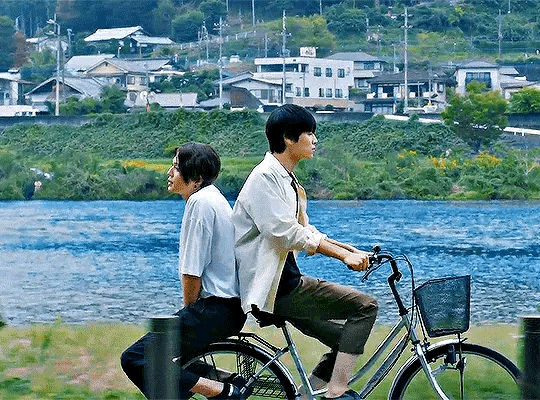
gif by @wanderlust-in-my-soul
Time to get a little weird! Weird is a key feature of Japanese media, and lots of jbls explore unusual relationship dynamics rooted in complex psychology. This is the first show on the list that will likely feel very Japanese if you’re new around here—my advice is to lean into it and finish the show, even if you get uncomfortable along the way. In Japanese media, discomfort always serves a purpose. This is a high school story with a twisted relationship at its center, and I’m not saying any more than that. Don’t spoil yourself and go watch it! This one also comes with two sequels—one short second season and one movie—that continue from the original story. They are less essential but still excellent.
I Cannot Reach You (Netflix)

gif by @my-rose-tinted-glasses
Next up, another high school tale, but with a totally different vibe. This show is kind of a revelation in its willingness to tell a story about overwhelming desire—including sexual desire—with young protagonists. It’s rooted in a classic but often misunderstood trope, friends to lovers, and takes the angst of it seriously, giving us a low stakes story that feels extremely high stakes to our leads. It’s also gorgeous and uses a classic Japanese visual style (bokeh) that you’ll be dying to learn more about.
His (Viki)

gif by @gabrielokun
Time for a break from high school, and we’ll sprinkle in a movie for some added flavor. His is a jbl film featuring a second chance romance between a stoic, introverted man who moves to a remote town to start over, and his ex-boyfriend who follows him there unexpectedly, adorable child in tow. Importantly, this movie does not take place in what we often refer to as the “bl bubble” where homophobia doesn’t exist; the leads’ experiences of being gay men in a homophobic society are hugely important to the plot and themes of the story. It’s a beautiful film and I’ve lost count of how many times I’ve watched it. @bengiyo would surely also like me to tell you that this film follows a brief prequel show called His: I Didn’t Mean to Fall in Love about the characters originally meeting in high school; I do not think it’s really necessary to watch it but completists can start there.
The Pornographer series (Gaga)
By now you should be ready to get into some classic Japanese fucked up psychosexual material, right? Right! The Pornographer series is told in five installments in this order:
The Novelist, a six episode miniseries
Mood Indigo, a six episode prequel series
Spring Life, a 15 minute short
Pornographer: Playback, a two hour film
Spring Life Continued, a 15 minute short
Confused by that distribution model? So say we all; sometimes Japan likes to make us work for it to make sure we really appreciate its many gifts to us. The story across these installments is about a very difficult to love protagonist, what makes him the way he is, and the also-unhinged-but-in-a-different-way man who finally gets through to him. It’s an extremely satisfying love story and one of the best character arcs I have ever seen, full stop. For this one, you’ll want to just pull the word problematic out of your pocket and store it in a drawer; nearly everything that happens in this story is problematic and that’s the point. Lean in! All of these installments except for the film are on Gaga, if you get that far hmu and I will supply you with the final puzzle piece.
Our Dining Table (Gaga)
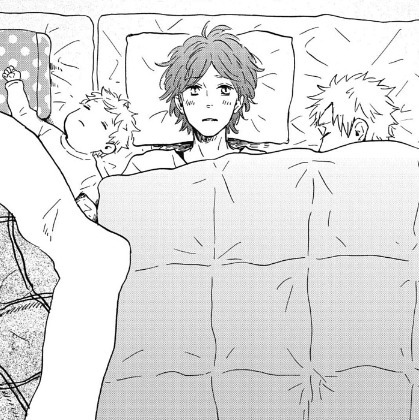
You could probably use a break after those last two, so it’s time to shift over to a heart-tugging twofer: family trauma mixed with the cutest shit you’ve ever seen. ODT is an example of another classic type of Japanese show: the food drama (you will see the GOAT in this category at the end of this list). In Japanese culture, food is love, and the act of preparing food for your loved ones is a common path to romance. You’ll love this story about an isolated office worker who meets a pair of brothers, learns to cook as a way of connecting with them, and begins to heal from his own trauma as a result. The image above is a scan from the manga, which @troubled-mind curates to make extremely cool comparison sets like this one. Many jbls are faithful adaptations of yaoi manga source material, so it’s good to have a bit of familiarity with them.
Minato’s Laundromat (Gaga)

gif by @liyazaki
Japanese media loves to explore taboo, and often manages to do it in a way that is surprisingly light and chaste. This is an age gap romance between a teenager and his adult neighbor that explores internalized homophobia, emotional repression, and falling in love across seemingly impossible social chasms. It’s also a great example of old school yaoi seme-uke dynamics that still show up across the bl genre. Also, take my advice: end your journey with this one with the first season and just pretend season 2 doesn’t exist.
Eternal Yesterday (Viki)

gif by @wanderlust-in-my-soul
Remember what I said about weird? Time to do that again, but with a heaping dose of grief and pain on top. It’s not a spoiler to tell you this show involves a major character death; a major character death is, in fact, the root of the entire story. This is a magic realist tale of first love turned tragic, and it will hurt and heal you. It is one of my favorite dramas of all time.
Restart After Come Back Home (Gaga)
And now for a break for your poor exhausted brain. This film is basically the jbl version of a Hallmark original movie, about a city boy who goes back home to the country and falls in love with a total sweetheart while working together on a farm. Enjoy it, bestie, you’ve earned it!
Tokyo in April Is… (Gaga)

gif by @wanderlust-in-my-soul
You’ve probably noticed by now that emotional repression and failed communication are big themes in Japanese works. This second chance romance has plenty of both, and it’s a great example of a kind of muted emotional style that Japan does so well, where the surface of the story seems almost placid and calm even as deep emotion roils underneath. This one (and Eternal Yesterday above) are part of a special line up of jbls on Japanese channel MBS called Tonku (Drama) Shower. The shows air one after another in the same time slot on Fridays (in Japan, perhaps Thursdays for you depending on where you live) and you truly never know what you’re gonna get, but they’re all interesting. Warnings on this one for sexual assault and trauma.
The End of the World With You (Viki)
Time for sexy and weird again, but even more so! This has to be one of the most unique bls ever made; it goes to some truly divine and strange places, and it feels incredibly queer while doing it. Made by the same screenwriter/director of the Pornographer series with a lot of the same sensibilities, but in a more heightened apocalyptic setting. This one has existential angst, a road trip, a redemption tale, and a variety of interesting side characters in the mix.
What Did You Eat Yesterday? (Gaga)
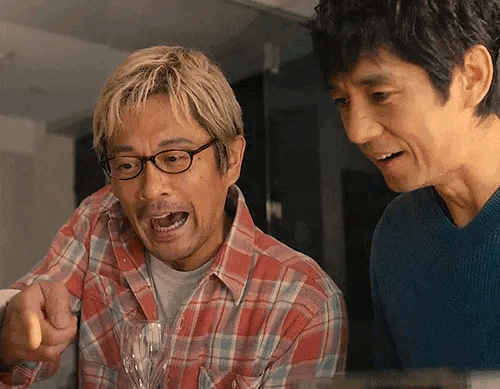
gif by @my-rose-tinted-glasses
Congratulations, you’ve reached the end of the list and your reward is watching one of the best bls of all time, and a perfect slice of life food drama to boot. WDYEY now has two seasons (along with a couple specials and a movie that fall in between) because the universe clearly loves us. You can now get it on Gaga for easy access but I’m partial to the versions over at @kinounaniresource for better subs. Wherever you watch, settle in to get cozy with Shiro and Kenji and make sure to always eat before you hit play.
#shan recommends#cherry magic#old fashion cupcake#utsukushii kare#eternal yesterday#our dining table#minato’s laundromat#what did you eat yesterday?#tokyo in april is...#his the movie#the pornographer#japanese bl#jbl starter pack
1K notes
·
View notes
Text
I just feel like talking about how deep Mikayu’s bound runs don’t mind me (HEAVY spoilers ahead).

Lets get this straight : i don’t care if you ship them or not (even if you would be a fool not to) but no one can deny that they’re literal soulmates and I’m gonna show you exactly why.
Yu and Mika were ALWAYS bound to find each other and reunite. I’m not saying that because I’m delusional it’s literally canon. Their relationship is as old as dinosaurs and once again : this is canon.
Yu (or should I say Mika but like whatever if you didn’t read the scans it would take an eternity to explain) was literally created for Mika. The sole purpose of his existence was to look after Mika and be his only friend. Since day one they were ment for each other.
They swore on every stars and defied fate itself that they will always found each other again no matter how many times they die or get taken away from the other in a way or another, no matter their race, age or era.

There I was talking about the first versions of them, but let’s talk about the main one, the one we all know in the anime and throughout the whole manga, Yuichiro and Mikaela Hyakuya.
Mika was the first one in this life to get Yu to open his heart, to make him accept his fate and push him to make the best of it. Yu was just a traumatized child that almost got killed by his own parents yet Mika made him feel like he belonged somewhere, he showed him that family wasn’t always meant to be bound with blood.
When Yu lost Mika it was like he lost all hopes, for the longest time Yu was suicidal, already from young age and this loss just made him feel so much worse. Yes the loss of his whole new family, including Akane and the kids was bad for him, but deep down what truly broke them was the loss of one another.
Years later they reunited, Mika like Yu both changed deeply because of their own experiences and yet their relationship stayed unchanged. Just the dynamic between them switched, Yu was now the one to convince Mika that he could trust his new family (Glenn and his own squad).
One day my mom told me « if when you reunite with a long lost friend and it feels like not even a day has passed, then it’s real friendship » and it’s been proven to me that this is true, Mikayu being yet another exemple of this.
As a vampire Mika doesn’t feel much anymore, it’s said loud and clear that turning into a vampire takes away from you any vulnerability, any love or lust. Yet Mika feels so vividly for Yu, it runs so much deeper than his own nature. His loyalty towards him is beyond any words could ever describe.
And it’s also so damn obvious how Mika is just so grumpy with anyone but smiles whenever Yu is around. He didn’t smile for anyone else than him throughout the manga, Yu is his literal everything, he is the only one that brings him peace and joy.
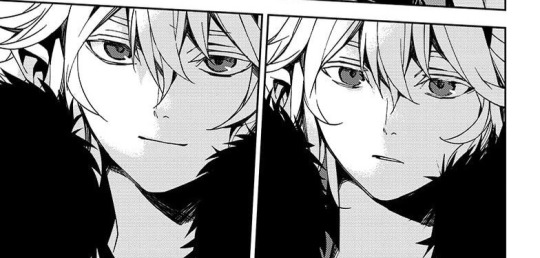
Now we skip forward a bit, Yu and Mika are in a deadly situation and against everything Mika dies. First let’s get the obvious out of the way, his last words were « Yu, I love you. ». I mean. There’s nothing more straightforward than that.
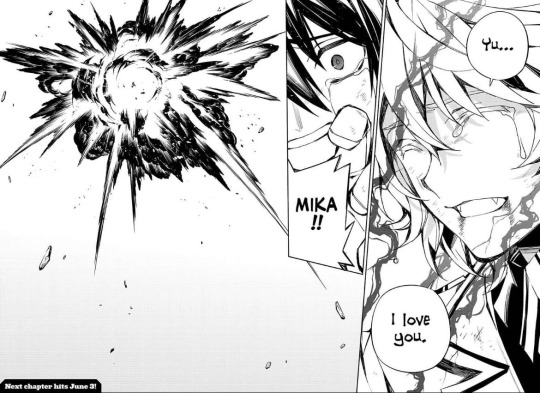
But then, when a vampire dies he becomes a demon, so of course Yu had to take him as his cursed weapon. So that’s exactly what he did, after so much struggle that I will pass here he finally got to talk with Mika and have a contract with him.
But the thing is when a vampire dies and becomes a demon he loses all his memories from his previous life, so Mika didn’t remember Yu at all. Yet, despite everything their bound didn’t die, quite the contrary. Even before they did the contract, so before Mika had access to Yu’s memories, there was still something inside him that screamed « that guy is important to me », even if he didn’t understand where it came from.

All the memories Mika had of Yu after that was again : from Yu’s own memories.
And what Mika saw broke him, the desire to die was so overwhelming even in his demon form he found himself speechless and hurt. He didn’t remember Yu but he knew that he was important to him more than he could ever tell. And he didn’t only see their memories together, he saw Yu’s whole life, the moment with his parents, the years they spent apart, Yu and Glenn’s relationship and his new family, he saw everything.
He swore his loyalty to him yet again, ready to do anything for him and face the end of the world hand in hand with him. And of course, even when he lost his memories Yu never once doubted him and that he would still follow him.
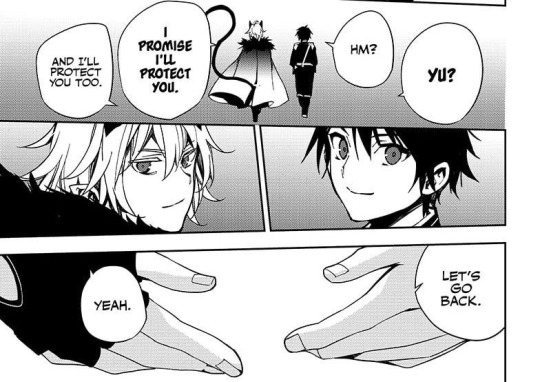
Now. I’ve been talking a lot about Mika’s love for Yu but what about the other way around ? Moving forward in the story again Glenn revealed something to Yu, his squad and Mika that left a dilemma hanging in the air. Yu had to chose between humanity and Mika. And what did he do ? He chose Mika, betraying not only Glenn, the man that save him physically and psychologically and that he respected the most in the world, not only his squad with who he shared ups and downs like a family but humanity itself for the survival of Mika.


If this doesn’t speak volumes to you I don’t know what will. Yu sacrificed EVERYTHING down to his own survival just to spend one more day with Mika. Now not only vampires, demons and angels were against him, but humanity too all for the sake of one man.
Both of them constantly put their whole life and universe on the line for the other and they always do it in a heartbeat, like any other decision would just be unthinkable.
They had so many discussions that made clear how deeply their feelings for one another go, no matter if you interpret it as brotherly or romantic love. They confessed to each other so many times how they can’t live without the other, how life is meaningless if the other isn’t around. How there’s not even a point in trying to live if it isn’t to face tomorrow together and how each other’s happiness is more important than anything else in the world.

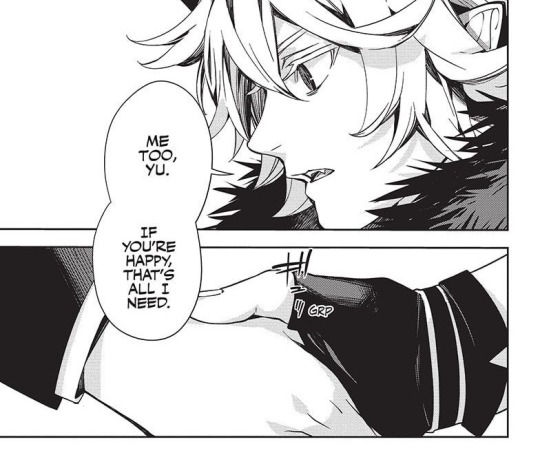
Both of them held on solely for the other, both of them are still breathing and living their truth thanks to nothing else than one another.
Their love is so fucking beautiful and pure, it stayed untouched through generations and generations of them.
Mikayu is an amazing ship and anyone would be a fool to not read Seraoh of the end just to witness such utter and raw love.
#seraph of the end#owari no seraph#mikaela hyakuya#mika hyakuya#mika x yuu#mikayuu#mika#yuu hyakuya#yuuichirou hyakuya#yuichiro hyakuya#mikaela x yuichiro
592 notes
·
View notes
Note
Hi, i'm a newish bl drama watcher from thailand that just started watching thai bls. i'm a bit ashamed to say that for a long time as a gay man living here i've been avoiding bl shows like the plague cuz of both the fandom reputation and of misconception from my yaoi era which i leave far behind. i'm just want to ask how did you got into watching thai bls and what were you preconception before you got into it.
Welcome to the Tumblr side of BL fandom. I'd actually like to also hear more of your experience with yaoi and BL as a gay person growing up in Thailand if you're willing to share.
For me, I'm a Black American from the Gulf Coast (the South). I grew up in a Catholic city and spent my entire adolescence in the closet. Despite having a sense of who I was as early as 8 years old, I kept most of that to myself. Because I didn't talk about it much with people, I found out most information about queer media and queerness from the internet.

I entered BL via queer cinema. I think the first explicitly gay character that I remember from TV was Marco from Degrassi: The Next Generation. There were probably others, and definitely more subtle expressions, but when I think about the oldest gay character I remember and connect to, it's Marco. I don't like counting things like shipping Shawn and Corey on Boy Meets World or Tai and Matt on Digimon for oldest gay characters. Sailor Moon can't even count because we got a censored version of it in America.

I got access to satellite television away from observing eyes around age 16 and started watching content on Logo back when they aired gay content regularly. I watched basically whatever I could late at night. It's how I saw movies like Get Real (1998), Beautiful Thing (1996), and Bent (1997). It's also how I saw Queer as Folk (2000-2005) Noah's Arc (2005-06).

After hitting adulthood I mostly got lost in video games and standard American TV for a while, but I did basically show up to any Gay Event in TV. I appreciate that Stef and Lena from The Fosters (2013-2018) were some of the only TV lesbians to survive the horror of 2016.

I watched a bunch of movies in this time, many of which appear on the Queer Cinema Syllabus I made for a hypothetical Westerner new to BL and queer cinema, which @wen-kexing-apologist has decided to try to complete.
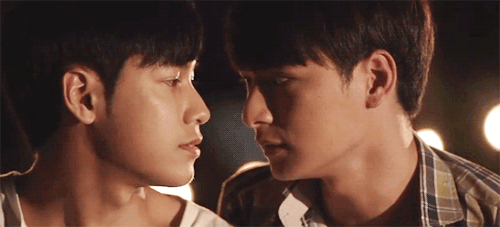
I got into Thai BL in 2018 accidentally. I started seeing gifsets of Kongpob telling Arthit he'll make him his wife passing around Tumblr and was basically like, "Right, what's all this then?"

I had watched a few Thai gay films, mostly notably Love of Siam (2007), Bangkok Love Story (2007), How to Win at Checkers Every Time (2015), and The Blue Hour (2015), but this was the first time I was seeing a long series made available so easily from any Asian country.
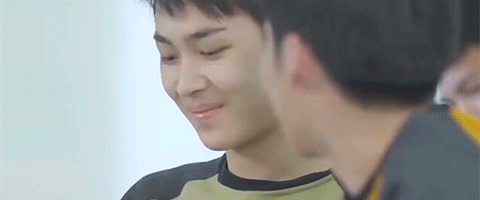
From there I got into Make It Right (2016-17) and Love Sick the series (2014). Once I realized that yaoi had moved beyond manga and a few anime adaptations, I went looking for a lot more. I basically haven't left since I started in about 2016 with SOTUS.
There's my basic entry into the genre. I don't think I was as worried about fandom and worries at the time because so much of being a fan of queer cinema was a mostly-private experience for me for so long. I didn't realize that BL fans active in the space would predominantly be women or queers figuring themselves out. It took a while to adjust to that, and also to adjust my expectations of the kinds of queer stories BL distributors were willing to fund.

That being said, I tend to agree with @absolutebl that BL has a useful role in normalization for non-queer audiences who encounter it. I like cheering BL when it does things I think work really well, and also deriding it when I think it does things that are offensive to help nudge the genre and offer my perspective as a gay man.

I like the place we're at right now where there's way too much to watch for any person with other hobbies and responsibilities because it means that people can pick and choose what's to their tastes.

More often than not, I'm probably most-invested in something airing from Japan because of my melancholy nature, but there's so much variety these days that it's okay if you don't like everything. I certainly don't!
I'm glad you joined us on Tumblr and look forward to your thoughts!
160 notes
·
View notes
Note
can i ask a thing about kabru as an anime-only... it's become kinda obvious at this point that there's a larger explanation for how he behaves that we haven't reached yet, but i was curious specifically in regards to those corpse retrievers that his party came across during their initial introduction. it makes sense that kabru would want to kill them considering their shady dealings, and we know that people in the dungeon can be revived, but his party did throw their bodies in the water afterwards, seemingly so they wouldn't be found and brought back to life? i was kinda waiting for this to be brought up again, but it wasn't...
Sure. The way I see it, the corpse retrievers are a seriously dangerous group playing with other people's lives for profit. Kabru in particular sees this behavior as unforgivable, and looks down on people who treat the dungeon as a "money pit" and not as a deadly threat that needs to be neutralized as soon as possible.
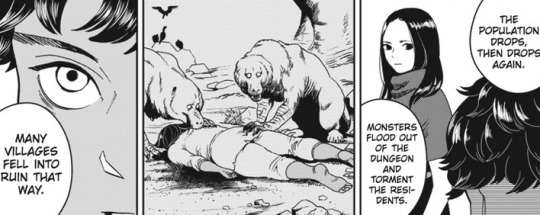
I'll add some visual aid from the manga, since I'm not gonna go hunting for gifs, but I won't include anything past the point we're at in the anime.
This interaction was cut for time, but early in the manga (after the Tentacles chapter), Namari explains the hazards of resurrection to the twins (and the audience):
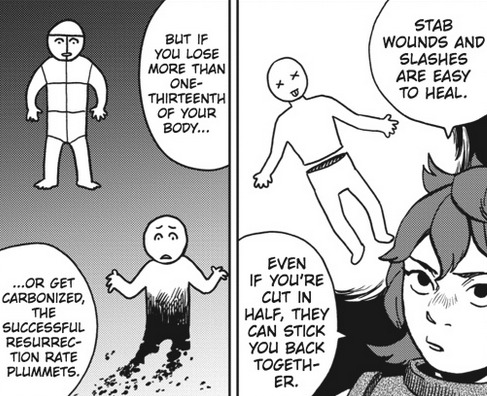
...which ups the stakes for us during the corpse retriever confrontation, when Kabru says this:
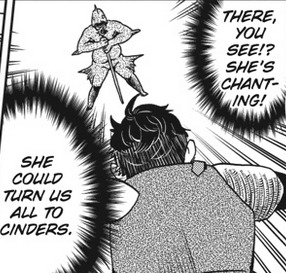
Which shows that the corpse retrievers aren't merely killing people to revive them for profit- already really fucked up- but doing so in such a reckless fashion that they could easily botch the job and end up with corpses unable to be revived. Imagine if this had been Marcille with her trigger-happy explosion spells? They would have bemoaned the lost payday, then probably just looted what was left.
And then their leader tries to rope Kabru in on their murder-for-money scheme, on the guy's own companions, just to get Kabru to keep quiet? Kabru clearly decided these people were too dangerous to live. Before this moment, all Kabru does is say that he's going to report them! He isn't the one who escalates the situation.
And with the threat to report them hanging over their heads like that, I don't think it would have boded well for Kabru's party if they had given the corpse retrievers a chance to be revived and come after them.
Even if they had miraculously decided not to hunt Kabru's party down (which they had already been doing this whole time), they were just going to keep preying on other adventurers, reducing the dungeon's own imported immune system meant to keep the ratio of monsters stable.
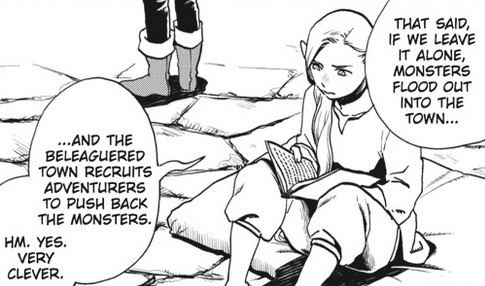
Which is not even as bad as it could be.
Making the choice to execute them is harsh, but honestly I can't judge Kabru that much, as a character in a story whose day-to-day includes life-or-death stakes.
In a storytelling sense, it's also helpful to see the way that Kabru is counterbalancing Laios's story: while Laios is journeying through a biological ecosystem and showing us the dungeon as an organism, Kabru shows the audience the human ecosystem that surrounds the dungeon, the political and social machinations working on it, and how these things are just as deadly as monsters. He's a big picture thinker.
More on that in ... a few episodes, probably?
On the off-chance you'd like to read it, the manga is easily accessible in its official translation here and is a very quick read. You can also see about checking it out through your local library; my roommate read it all on her e-reader that way!
I hope I helped!
#hello fandom! this was fun! do not come onto this post and bitch at me though <3 thank you#Dea's anonymous friends#Dea answers#musings with Dea#dungeonposting
131 notes
·
View notes
Text
The Reproductive Horror of JJK Part 2 (Dealing with Trauma)
Part 1
Notes before we start.
1) This analysis deals heavily with topics of nonconsent, grooming, abuse, and reproductive manipulation. Please proceed with caution.
2) This post was inspired by @hermitw and @tangsakura
3) Read the light novels. They are the equivalent of Bleach's CFYOW for JJK. There is a fan translation (Book 1 & Book 2), but I will be citing the official translations from my own copies.
4) I will be mainly using the TCB scans for the manga because of their accessibility.
5) Written as of JJK 265.
(Click images for captions/citations.)
Preface
This was written with the assumption you've also read these other analyses:
Thoughts on Sukuna and Kenjaku’s relationship as of JJK 258.
Gojo's You Pronouns (Gojo's Relationship with Toji and Geto)
Please give them a quick glance at least.
...
Some of you may have found it odd that a discussion about bodies being irreversibly changed and used left out Mahito whose ability quite literally irreversibly changes bodies for them to use. That was deliberate. Blame Tumblr’s 30 photo limit.
The previous post was actually about Mahito.
Mahito
For series that has a power system based on strong negative emotions, it is a bit odd that curses surrounding sexual trauma aren’t ever directly mentioned in this work. You could chalk it up to the series being Shounen and not Seinen. But that is precisely why I think JJK delves into the topic using abstract representations. It allows the topic to be explored in a way that connects well with those who’ve experienced it without being too graphic for the younger audience.
Though Kenjaku is a literal rapist, I argued the methodology and effects behind vessel creation resemble rape. Someone's body belonging to another through force, permanent changes brought about after experiencing immense trauma, being groomed into tolerating it as a natural part of this world… When I think of a curse equivalent to this, there is no one other than Mahito that fits.
The transfigured humans Mahito creates are through nonconsentual touch that strips them not only of their autonomy, but their clothing as well. These people are in immense pain from the distortion of their bodies and can never be returned to their original state. In this way, transfigured humans can be read as a stand in for victims of sexual assault.
I didn’t propose this idea first. The Tumblr user that inspired this entire analysis, hermitw, did so in this post (please read it, it's very good). This person’s ideas will be reiterated in this discussion and I will expand upon them starting with how poorly other characters react to their Cursed Technique (CT).
Breaking Composure
Mahito sets themself apart from other curses by how they’re able to get under the skin of the most seasoned sorcerers. It’s not because of their words but the transfigured humans.
Nanami is heralded as the no-nonsense man. Nothing gets to him. He is always calm and professional no matter the circumstances. Mahito's first interaction with him immediately throws him off kilter.

We saw how much fun Gojo was having beating Hanami to death and tearing Jogo apart. That stops entirely when the transfigured humans show up. Yuji can see it coming too. This is the first time during the fight that Gojo’s composure visibly breaks. His reaction to Mahito isn’t any better. There are no smiles and he looks to be in shock.

Gojo’s Six Eyes allow him to see Cursed Energy (CE) to the point where he can infer someone’s CT at a glance. When he sees those transfigured humans, he’s probably seeing the extent of their pain in how the CE controls their souls.
I also want to point out that sexual harassment on trains is such a massive problem in Japan that they have special cars for women. There’s something to be said here about a train full of people that can represent victims of sexual assault.
This visceral disgust when it comes to Mahito isn’t limited to the protagonists either—the main antagonist, Sukuna, finds them to be repulsive after a few interactions. In this instance, Mahito's touching of Sukuna's soul is straight up compared to a patron harassing a hostess.

Just like Gojo, Sukuna goes from having fun to having a really bad time in an instant.
I bring their reactions to Mahito up because there is something off about it. These are all characters that hardly balk at the gore and death brought about by curses. It’s as if Mahito’s brand of violence needs to be categorized as something else.
If Mahito is seen as the embodiment of sexual assault, this is in line with how sexual violence is separated into its own category for treatment and study. When compared to non-sexual violence, the lasting effects are so severe it's not helpful to treat it the same way.
And that’s just what Mahito is. An exceptionally dangerous curse that Jujutsu Society deems needs to be exorcized before it destroys everything because barely anyone can deal with its effects. Likening that damage to something on par with natural disasters is significant.
Mahito as a Natural Disaster
Mahito is the leader of the natural disaster curses despite being born of humans. Hanami, Jogo, and Dagon are forms of wrath spawned from environmental damage brought about by humans. When nature, the ocean, or volcanoes cause mass death, people accept it as a part of living in this world. Sometimes they’ll go as far as to blame others for causing their own demise by living so close to it.
Mahito doesn’t seem to fit into this category unless you consider how widespread sexual assault is. In the US alone 81% of women and 43% of men reported experiencing some form of sexual harassment and/or assault in their lifetime. These numbers are likely higher due to the underreporting of this crime in general.
In 2021 it was estimated that 101.8 million people were affected by natural disasters or about 1% of the current 7.9 billion population. By 2050 some estimate that 1.2 billion people will be displaced by climate change related natural disasters. That’s about 15% of the current population.
Compared to natural disasters, sexual assault certainly rivals their numbers. But when compared to reporting? It’s under discussed. People chase storms. Natural disasters are tracked extensively by the damage and cost. Nations build infrastructure and plan around them. They’re acknowledged as a problem that is to be dealt with. The victims of sexual assault get no such attention. Warnings against perpetrators are often ignored and the victims are something people would rather keep invisible.
Mahito is a lot like that. Able to go about unnoticed as they stockpile thousands of humans whose bodies disturb those around them. The transfigured humans are targeted first by sorcerers both because it’s easier and because the one creating them seems untouchable.
Mahito’s effectiveness as a curse is their ability to force people to reckon with the worst humanity has to offer. They mirror every little sin and exploitation committed by others, putting it on full display with their manipulation of Junpei.
Just like Mei Mei grooming Ui Ui with inappropriate but gentle touches and praise…

Just like Kenjaku manipulating the vulnerable to gain access to and use their bodies, only to betray them in the end…

You might call Mahito Kenjaku’s protégé. Really taking after all the worst aspects of that bastard. However, I have read CFYOW. Mahito’s true source of inspiration comes from someone unexpected.
Allegory in Darkness (JJK Summer of Ashes, Autumn of Dust, Chapter 3)
Before Mahito met Junpei, they met a blind homeless man living under a bridge. Their interactions with this man fundamentally change their view on humans and their approach to breaking them. This short story is one of the most harrowing things I’ve ever read. The quiet horror of JJK is on full display here. I’m not going to summarize all of what happens. Just read this.

This old man is so detached from himself and the world around him that he has essentially become nothing. He exists as a thing. This fascinates Mahito and they decide to observe them, forming a weird sort of companionship with him. Eventually, Mahito learns why the old man is this way.

Immense trauma. Abused and disfigured, the old man gives up on everything and in turn is freed from his suffering. Mahito likens his state to enlightenment Buddhist monks may achieve.

They’re not wrong about this. Buddhism is centered around the escape from suffering via detachment. But there’s something greatly unsettling about this situation. Unfortunately that never gets addressed, the old man dies and Mahito oversees it.

And what’s this? Right at the end. The old man appreciates Mahito for being there for him. His “enlightened” state is revealed for the facade that it is, causing his soul to waver. He appreciates that his suffering has been acknowledged by another and dies satisfied, leaving Mahito both in a state of mourning and with the perfect way to manipulate someone before they pass.
What a human is to Mahito.
There’s a lot I left out in my summarization of Allegory of Darkness. Mainly the little discussions they had to build a relationship. They’re centered around movies and books because Mahito uses those to understand the humans around them.
From their studies, they conclude the following.

Humans are creatures that eat, sleep, and rape while curses are creatures that deceive, cheat, and kill. But I’d like to break down the kanji Mahito uses for their description of humans.
食 (ku) is usually read as "ta" which is in line with regular eating. The "ku" reading is more like devouring and it can be a sexual innuendo.
寝 (ne) means to sleep. And just like in English it can mean to have sex with someone.
犯す (okasu) is the tricky one. It can mean to commit a crime, to break, to violate, to contravene, to deflower, to rape.
Translating this as rape isn’t wrong, but it can overemphasize the sexual connotation. Okasu is more about the nonconsent. Doing something against another’s will.
However in Mahito’s case, they’re most definitely drawing attention to that. The eat uses the ku reading and is next to sleep with heavy innuendo. Okasu implies an assault on a body that does not belong to them. With this in mind, I think eat would be best localized as consume to get across the greedy inconsideration.
This isn’t coming from nowhere. They watched such a thing occur first hand. That old man I mentioned? He’s killed by two random men on a dare because they see him as something for their consumption. His body doesn’t belong to him. It’s a thing for them to play with.

Kenjaku, a human, reinforces this behavior by having Mahito participate in death womb painting incarnations and other manipulative schemes. And in the end, Kenjaku causes Mahito to fall to the same victimization they learned from humans.
Mahito sees humans, not curses, as creatures that take without consideration. They’re beings that have made the violation of boundaries so commonplace it can be seen as natural. And he’s not really wrong about that in the context of this story. All the stuff I mentioned in the previous post—it’s both right there in your face and nearly invisible.
The acts themselves are never depicted but always implied. It’s an insidious thing that goes ignored or is outright denied by fans. Anyone who has experienced these things, recognizes it, and points it out will be chastised for reading too much into it.
But can you blame them? The perpetrators are named. They’re goofy and strong and interesting. Their victims are footnotes with little presence and are sometimes outright denied names. And yet they’re always there, just out of sight, suffering in the background.
How horrific that this mirrors a victim’s experience almost identically.
Mahito vs Yuji
The first time Yuji kills a human, it’s as a mercy. At the request of the transfigured human, Yuji puts them out of their misery.

It’s a sin Nanami has been trying to protect Yuji from as a child and Mahito forces it on him with a cruel choice between leaving them to suffer or ending it for them. Yuji chooses to liberate them from suffering.
I think Yuji is able to see the outline of Mahito’s soul, not because of Sukuna, but because he is willing to see Mahito for what they are and face them head on. He doesn’t hide how the transfigured humans or deaths affect him. He cries over them and carries on with that hurt.
And it’s painful. Yuji vomits and wails on the floor. But he deals with it. Unlike his mentors who bury their emotions and pretend everything is ok.
This is what makes Yuji fundamentally incompatible with Mahito. He is the exception that won’t allow Mahito to go unnoticed and slip away. He does it for their victims and himself. And still Mahito taints him. Yuji starts to see himself as a cog no different than Mahito.
He carries that mentality until he finally confronts Sukuna in JJK 265. Acknowledging why he started thinking that way in the first place, moving past it and onto something better.

That’s what I love about Yuji the most. To him, anyone’s trauma will never be invisible.
And the horror persists…
Even though Yuji is this tiny beacon of hope in this rather depressing narrative, there’s still so much he can do as a 15 year old boy. The trauma he takes on and deals with is only for those he was witnessed or has been told of. This means a lot of the characters don’t have their grievances addressed in a way that gives me comfort.
The old man under the bridge may have died satisfied, but I can’t stop thinking about him. His suffering and isolation masked by numbness went on for decades. The happiness he experienced at the end was for seconds. And the worst of the worst, Mahito, was the one to comfort him…
I can't stop thinking about the old man under the bridge.
There’s a lot I left out in my summarization of Allegory in Darkness. I really wanted to include more, but I found it to not fit into the rest of this discussion. Strange little bits of dialogue like these.

When I read these passages, a single question lingers in my mind.
Why does this man resemble Sukuna?
I lied. This post is actually about Sukuna.
Let’s go back to that homeless old man under the bridge. Mahito admires him as enlightened, but anyone can his state is mortifying. He has coped with the abuse, disfigurement, and suffering by becoming nothing. No different than a rock. He has no name. He’s not a person. He feels nothing. And the worst thing about it is how that’s technically better than being tormented by those memories.
JJK asks how does one cope with trauma? And repeatedly this question is answered by most characters in one of two ways:
1) You let it consume all that you are.
2) You become nothing as you detach yourself from it entirely.
The old man under the bridge is what Gojo tried to and failed to become. As much as he pretended otherwise, his attachment to grief and love controlled him. Sukuna mocks him for this. Calling him painfully ordinary in the English localization isn't incorrect, but it strips away that religious context. In Japanese this kanji 凡夫 (bonpu) can be read as Unenlightened.

The old man reached enlightenment while coping with his trauma. It worked for so long. But right at the end, when Mahito shows some semblance of care for him, those feelings he thought were shaved off cause him to waver.
A new question plagues my mind.
What the hell happened to Sukuna?
It’s presented as a humorous thing. Framing Mahito’s nonconsensual touching of Sukuna’s soul as a handsy patron ignoring the boundaries of a hostess.
Gege sometimes introduces character quirks as something funny before they’re revealed to be induced by trauma. Gojo Satoru is the biggest culprit of this with his sweet tooth and manner of speech and childish behavior that desperately tries to claw back the youth that was stolen from him.
Sukuna has such an averse reaction to having his soul touched by Mahito. He’s wearing women’s clothes when it happens. He’s likened to a hostess for it.
When we consider this and the quiet way misogyny and sexual assault is woven into this story… And how Gojo, the Strongest, was preyed on by older women. And how Yuki escaped having her body being used by someone much older than her by becoming strong. And how Rika, the Queen of Curses, is likely a victim of CSA by someone who was supposed to take care of her. And how Mai, a twin and a victim of CSA, creates a stronger twin by dying when she can no longer cope with her trauma.
I don’t like what this suggests for Sukuna at all.
Sukuna is willing to bond with all the other natural disaster cursed spirits, except Mahito. He himself became something akin to a natural disaster so it makes sense he liked the company of those like them. It’s him rejecting the strongest of the bunch because of how their CT violates others’ bodies is something I cannot overlook.
Jogo’s fire is so kind in comparison. The bodies he burns and the corpses he leaves cannot be defiled by anyone. It’s what would’ve prevented Geto’s body from being stolen. And hey! Sukuna returns the favor, burning Jogo in a way that prevents Kenjaku from absorbing him.

The easiest way for Sukuna to permanently scar and traumatize Yuji is to inflict sexual violence on him or his loved ones. JJK does not shy away from having rapists like Noaya and Kenjaku do just that. A common complaint from fans is Sukuna not trying to manipulate Yuji into working with him. JJK does not shy away from having groomers like Kenjaku, Mahito, and Mei Mei (and to an extent Tengen) do just that.
Sukuna is strong and clever enough to do these things, but he doesn’t. I think there’s more to this than a disinterest in sex.
Choso’s mother faced ostracization for her unique body that allowed her to give birth to hybrid children. With nowhere left to go she wound up at a temple for sorcerers. Kenjaku took advantage of her situation and body, partaking in her rape to satiate intellectual curiosity.
Sukuna faced ostracization as a child for his unique body that made him a great sorcerer. Just about everyone who knows him has tried to exploit his abilities for their benefit.
There’s a massive blank in this parallel. What happened to Sukuna growing up to make him this way? Every time I try to fill in that blank with the information we have now, I’m left with something deeply unpleasant.
When Sukuna has flashbacks, it only ever goes as far back to his time as Yujikuna. He verbally recounts his time in the womb and there’s nothing else. The first time we see Heian Era Sukuna in full, it’s from Yorozu’s memory. And if you recall…this introduction is him being sexually assaulted.

Sukuna’s fingers are scattered everywhere, fragments of himself are throughout the world and in a little bit of everyone. A curse that cannot be destroyed that only gets stronger with time. He’s something that was repressed despite everyone knowing he exists—a victim of sexual abuse.
Sukuna’s Backstory—Revised
Back when I theorized that Sukuna is an ex-slave, I deliberately withheld references to sexual abuse slaves are often subjected to because I felt it was too heavy for the post.
But seeing others theorize something that severe happened in part because of his CT’s name and spiritual pederasty practices at the time, makes me regret not including it. Please read the post by Tumblr user tangsakura that brought this to my attention.
Pederasty, if you do not know, refers to a boy having a sexual “relationship” with an older man sometimes as a form of “guidance”. The most known form of this originates from ancient Rome and Greece. I put “relationship” and “guidance” in quotations because children cannot consent to or grow from this kind of abuse.
Such a thing was common, sometimes socially accepted, systemic abuse in the ancient world. (Though a form of it exists to this day.) Japan partook in pederasty, even in certain types of Buddhist temples, prior to the Meiji Restoration in 1868. (Here’s a video source on it. Be warned it's pretty upsetting.)
And in most of these societies that accepted pederasty, a relationship between two men of equal standing was frowned upon or not tolerated at all. The imbalance of power and exploitation of children was the socially acceptable thing. Despite, you know, the resulting trauma and suicides of the victims.
As discussed in the linked video, the children at these temples were seen as pure and therefore closer to Buddha. Since celibacy between human monks was expected, fetishizing these children as gods allowed for the mental gymnastics to justify molesting them.
That’s not too surprising. Organized religion with massive followings all have it in common—the sexual abuse of minors and tolerating it or covering it up. What’s striking about this abuse is that it was considered important to or even necessary for enlightenment by some sects. Their suffering brought about enlightenment.
Mini crash course for those not familiar with Buddhism. There are 4 Noble Truths that are foundational to this religion. (Copy and pasted from Wikipedia.)
1) Dukkha: Suffering exists: Life is suffering. Suffering is real and almost universal. Suffering has many causes: loss, sickness, pain, failure, and the impermanence of pleasure.'Dukkha: Suffering exists: Life is suffering. Suffering is real and almost universal. Suffering has many causes: loss, sickness, pain, failure, and the impermanence of pleasure.
2) Samudaya: There is a cause of suffering. Suffering is due to attachment. It is the desire to have and control things. It can take many forms: craving of sensual pleasures; the desire for fame; the desire to avoid unpleasant sensations, like fear, anger or jealousy.
3) Nirodha: There is an end to suffering. Attachment can be overcome. Suffering ceases with the final liberation of Nirvana. The mind experiences complete freedom, liberation and non-attachment. It lets go of any desire or craving.
4) Magga: In order to end suffering, follow the Eightfold Path.
Per the 3rd Noble Truth, enlightenment comes from the end of suffering, not its continuation. The idea that suffering is needed for enlightenment contradicts this Truth. But that’s not surprising either. I was raised Protestant and I’ve got a whole laundry list of how that branch of Christianity seems to have ignored the basic fundamentals of Biblical text.
What I want to get into is the specific branch of Buddhism Sukuna appears to have been abused under—Tachikawa-ryū. Just as a heads up, information on this sect is limited as this person explains:
“Tachikawa practice became forbidden and the school’s ritual texts were destroyed. As a result, only a few original scriptures and rituals survived the persecution, which makes it very difficult nowadays to fully understand the teachings of the Tachikawa-ryū.”
(The wikipedia page is straight up missing citations so feel free to correct me if I get some stuff wrong.)
The destruction of records sounds exactly like what happened with Kenjaku and the Meiji girl. But the similarities don’t start or end there. This sect is accused of using human and animal skulls for rituals. And if you recall, Sukuna sits on a throne of oxen skulls. Other heretical acts included the consumption of meat, which at the time was forbidden. Another thing Sukuna loves to do.
But what this sect is most known for are the bizarre sex rituals needed for enlightenment. You know the thing Sukuna explicitly has no interest in. More excerpts about that from the non-wiki source:
“Since the idea of a world, created by the union of male (yang) and female (yin) elements, is the essence of cosmology in Tantrism, sexual union serves as the “real life” version of this dualism. In other words, sex is an effective way to achieve buddhahood in a relatively short amount of time (best case scenario: this life, “becoming a buddha in this very body (即身成仏 sokushin jōbutsu)”). Furthermore, much ink has flown on the description and discussion of a human skull ritual that involved sexual intercourse and the use of seminal and vaginal fluids to create an object of worship.”
This melding of male and female elements is everywhere in JJK. It’s a massive component of the reproductive horror too. Everything with Kenjaku is self explanatory. But Sukuna, who wears women’s clothes, is currently pregnant with the Merger, and has a gender ambiguous servant… He’s a part of this too.
It should also be noted that Tachikawa-ryū is actually a sub-sect of a sect. It originates from Shingon Buddhism. …Which was first introduced in the Heian Era.
Here are some quotes from the wiki article:
“The essence of Shingon practice is to experience the Dharmakaya, the ultimate reality, by emulating the inner realization of the Dharmakaya through the synchronized meditative ritual use of mantras, mudras (hand gestures) and visualization of mandalas.”
Oh hey that sounds like what Jujutsu Sorcerers do.
“The goma (護摩) fire ritual is an important and recognizable ritual in Shingon. The meaning of goma is to burn the firewood of delusion with the wisdom flame, consuming it completely.”
Oh hey that sounds like Sukuna’s fire CT.
“The most important Shingon mandalas are known as the Mandala of the Two Realms which are: The Womb Realm (Sanskrit: Garbhadhātu; Japanese: 胎蔵界曼荼羅, romanized: Taizōkai) mandala based on the Mahavairocana Sutra and the Diamond Realm (Sanskrit: Vajradhātu; Japanese: 金剛界曼荼羅, romanized: Kongōkai) mandala based on the Vajrasekhara Sutra.”
Oh hey that’s Kenjaku’s Domain.
I wasn’t raised any kind of Buddhist, so there’s probably a lot here I’m missing. My point here is that the symbolism and historical context are in line with Sukuna enduring some pretty horrific abuse as a child. It’s very likely that the way he behaves and thinks is one massive cope to rationalize what happened to him.
Identity and Trauma
Sukuna is a difficult character to grasp because he’s so unforthcoming in personal information. He’s not once introduced himself by name and reveals fragments about himself in very cryptic ways. Most of what we know about him is from other characters. (Much like how the original writings of Tachikawa-ryū are lost and the remaining info is sourced from outsiders.)
To better understand him, I’ve been working under the assumption that other characters reflect fragments of Sukuna that will eventually fall into place.
Sukuna is like Maki. Consuming his twin to survive and becoming stronger for it.
Sukuna is like Toji. Discriminated against for the way he was born, he becomes strong enough to separate himself from Jujutsu Society only to be dragged back in.
Sukuna is like Geto. Falling from grace and procuring a cult-like following.
Sukuna is like Todo. He’s completely self-centered and hates taking orders from those weaker than him.
Sukuna is like Mechamaru. Disfigured by birth, longing to connect with others, he finds himself at the end of a manipulative deal that promised him a second life.
Sukuna is like Kenjaku. He sees himself as above others and only wants equals for companionship. Other people are playthings for him to consume to stave off boredom.
Sukuna is like Mahito. Endlessly curious about the humans he was born of, he consumes their art and lives in an attempt to understand them.
Sukuna is like Yorozu. Obsessively pursuing a single person, trying to teach them love through violence.
Sukuna is like Yuji. Adapting to any situation with battle intuition like no other by understanding his opponent.
Sukuna is Gojo. I call them twin flames since they have the most in common. If you noticed, that homeless old man from Allegory in Darkness resembles Gojo a lot too. For this reason I often use Gojo as a reference to infer how Sukuna is as a character.
Gojo’s trauma that helped him reach his self-proclaimed enlightenment was Toji. And that was just normal assault. But let’s reframe that battle as something a little more abstract…
As a teenager Gojo has his Infinity, a barrier that kept him safe, forcibly penetrated by a much older man. This both kills him and awakens him to immense power that irreversibly changes him. His loved ones can no longer recognize him and his relationships are destroyed by this. His ability to feel pleasure and his sexuality are contorted in ways that others find deeply perverse.
This is the plot of Baby Reindeer—an extremely upsetting semi-autobiographical recounting of how the creator’s sexual trauma ruined his life.
But that’s not how everything is framed at first. The main character, Donny is introduced as a man trying to report his stalker, Martha, to the police.
Martha recognizes that Donny has been abused. Maybe not in the same way as her, but similar enough to the point where they become toxicly attached to each other. She stalks him and assaults him in what she believes to be acts of love. You both pity her for her circumstances and hate her for the destruction she causes.
That sounds like Sukuna doesn’t it?
Sukuna saw something in Gojo he can’t recognize in anyone else. And I think it’s much more than the loneliness that comes with being strong—It’s having your body violated and no one recognizing or taking your trauma seriously because you’re supposed to be strong.
Toji’s failed assassination attempt on Gojo resembles sexual assault in how Gojo reacts to the whole ordeal. He wants some kind of support but pushes everyone away. He craves touch but has a barrier to prevent it running 24/7. He both pities Toji and admires him, fears him and kills anything like him. His sexuality cannot be divorced from this incident, needing a good deal of violence to get off. It’s too similar to how Donny engages his own sexuality after his assault.
But to my knowledge, Gojo hasn’t been raped. He went through something that resembled it and Sukuna picked up on that. During their fight, Sukuna essentially dealt with that trauma. He became a sort of Toji that satisfied Gojo’s perverse needs while tearing through the very thing that had him targeted in the first place—Infinity.

This is the source suffering Sukuna seemingly liberates Gojo from with extreme violence like some kind of heretical Bodhisattva. There’s also something to be said about him using Mahoraga to do this.The Eight-Handled in its title is a reference to the Eightfold Path that’s to be followed in order to obtain enlightenment.
And they both have this trait in common—using violence to guide others towards enlightenment, a perversion of the 3rd Noble Truth. Gojo just calls it tough love.

(And notice how Megumi recalls both Sukuna and Gojo's words as he grows from a difficult fight.)
I know that Gojo does this because of his trauma with Toji and his own “growth” coming from it. It’s one of Gojo’s many destructive coping mechanisms. He’s stuck in the past trying to relive what was stolen from him. Like I mentioned before, Sukuna calls Gojo unenlightened for this. And if they’re twin flames, I have reason to believe Sukuna is the exact same way.
Sukuna finds Maki to be the most compelling of Gojo’s students. And I think there’s more to this than seeing a fellow monster in her. She’s what he wants to be.
Not only is Maki free of the sorcery that ruined their lives, she has confronted and dealt with her trauma. She killed the source of her suffering, the Zenins, and has accepted the death of her twin she was so dearly attached to. And unlike her mentors, Maki appears to be emotionally stable because she did this in spite of her trauma, not through it. The sumo guy's compassion is what guides her. In other words, she’s obtained enlightenment outside of violence.

Maki also succeeds where Toji failed. There isn’t anything left that would cause her to waver. She stays true to herself and remains enlightened.
That seems to be a recurring thing—characters deviating from their “enlightened” state through human connections that rouse their unresolved emotional issues and then dying. Toji’s projection of his trauma from Jujutsu Society onto Gojo gets him killed. Kenjaku’s desperation for companionship has Takaba create the perfect opening for Todo and Yuta’s ambush.

Sukuna has started to deviate from himself because of Yuji. And it’s probably because he’s projecting his trauma onto him. If that’s the reason both Toji and Kenjaku were felled, it’ll be the reason for Sukuna’s downfall too. Just like that old man under the bridge.
Sukuna and Yuji
Umineko no Naku Koro ni (When the Seagulls Cry) is a visual novel about a person who is fundamentally misunderstood by those around them. They desperately want to be loved without being perceived, believing themself to be unworthy due to trauma and immutable characteristics given to them at birth. Instead of telling anyone these feelings directly, they play games akin to torture. They torment the ones they love over and over in hopes they'll see through their actions and understand them.
I’ve always compared Sukuna to this character, but for this analysis I’ll be comparing him to another from Umineko—Rosa Ushiromiya.
The youngest of 4 from a rich conservative household, Rosa was subjected to physical and verbal abuse by her father and older siblings. As an adult around them she cowers. She shows her abusers respect they don’t deserve because of her social standing within the family and tolerates their jeering.
But with her little 9 year old daughter who can’t fight back? She beats her the moment she makes any mistake. As she beats this child she screams about how everything is her fault. Rosa projects her financial woes, her childhood abuse, and systemic misogyny all onto this child that never asked to be born. She blames this child for her own shortcomings that keep her tethered to her abusers year after year.
The sad thing is that Rosa doesn’t realize why she’s doing this. She is unable to come to terms with her own trauma and remains stuck in the cycle of abuse as both a victim and a perpetrator, unable to spare her daughter from it.
Knowing that Sukuna and Yuji are blood uncle and nephew. And knowing that by technicalities, Yuji would be genetically recognized as Sukuna’s son…I see that kind of hurt in their relationship.
Sukuna is a very good liar. Most take him at his word. He says that he hates Yuji for his ideals—how he puts his life on the line in service to others. The things Megumi, Higuruma, and Gojo do as well. And yet Sukuna admires them. Todo sacrifices himself to prop up Yuji and save Hana. Sukuna calls him a true sorcerer for this. It’s not unreasonable to conclude that Sukuna isn’t being honest about why he hates Yuji.

I think it’s because Yuji is somehow linked to Sukuna’s trauma through no fault of his own. And because Yuji is easier to target, Sukuna uses him as an outlet.
We’ve seen this scenario play out before in JJK. Mai lashes out at Maki instead of Naoya or all the other men like Naobito who enabled or partook in her abuse because it’s the safer thing to do. She doesn’t actually hate Maki. She hates what she has to endure at the Zenin Clan and sees it as inevitable. Fighting back is scary and she really hates doing that. If the manga didn’t make that clear, the CFYOW: Thorny Road at Dawn, Chapter 4: Advancing in the Face of Fear sure does.
Yuji isn’t a cage to Sukuna because he chose to be this way. Kenjaku made him for it and even manipulated him into ingesting the fingers. But you know, Yuji is someone Sukuna can attack without consequence.
I do not know if Kenjaku is the person who abused Sukuna or if Kenjaku merely resembles the person who abused Sukuna. Kenjaku is older than Sukuna, has a fascination with him, and has manipulated him. There are plenty of other characters that have been traumatized by Kenjaku.
Whatever the true nature of their relationship is, Sukuna is choosing to attack a symptom of his restriction instead of its source. He’s behaving no different than Mai or Rosa which leads me to believe there’s something deeper to his hatred of Yuji.
Yuji’s Role
I think that Yuji is aware something terrible happened to Sukuna. He’s not really sure what. The type of abuse Sukuna likely went through is not common historical knowledge even in Japan.
For the longest time, Yuji regarded Sukuna as a curse and denied him his humanity. But as of JJK 265, Yuji treats Sukuna like a human. He takes him through his memories and plays little games with him. He rejects the cog mentality Mahito groomed him into and says this:

“I could very well be doing the wrong thing here. So I thought I should at least let you see the humanity of someone other than yourself.”
Yuji is admits that his approach to Sukuna may be flawed.
And flawed it is. This entire chapter and offer Yuji makes to Sukuna might be one of the cruelest things he has done so far and he isn’t even aware of it. Yuji is recounting a pleasant childhood full of love and quiet moments. That’s something Sukuna didn’t have because it was taken away for reasons beyond his control.
This accidental cruelty isn’t anything new. It happens right before Junpei dies to an ability that resembles sexual assault. Yuji reaches out to him and asks what’s wrong. He notices something is off and tries to console Junpei through it.

And here he apologizes for saying something so insensitive. He didn’t know, but he had to ask. Sukuna was there to see that.
I think that's what Sukuna wants from him. He wants Yuji to acknowledge he was hurt. To recognize that something happened to him and offer something like he did with Junpei. It’s a bit odd that he humors Yuji’s kindness towards him instead of immediately opening his domain as a counter. This could be an explanation for that.
Yuji hasn’t given Sukuna the same treatment yet. In fact he’s done the exact opposite thing he does with other people. Yuji usually lets his opponent yap at him and meets them as they are. This time, Yuji is the one who does the bulk of the talking and he doesn’t give Sukuna a chance to open up about himself.
That’s not his fault at all. He’s 15 and it’s not his job. The reason he thought Sukuna was a curse for so long is because everyone else told him he wasn’t human and Sukuna never denied it. But just like with Junpei, Yuji did something really insensitive.
Yuji showed Sukuna pity then told him to die or go back into his cage.

People picked up on Yuji being posed like the Fallen Lucifer painting. I think it’s deliberate this offer is being framed as villainous. If Sukuna is outright revealed to be a former slave or a victim of CSA, on reread this would come across as wicked.
It wouldn’t be the first time a scene goes from hype to depressing on reread. I loved watching Yuji and Nobara grow as they killed Eso and Kezichu. After Choso? That fight breaks my heart. Yuji has been manipulated into killing his own brothers and he didn’t even know it.

Yuji’s status as a cage is likely reminiscent of whatever bound Sukuna to the abuse in the first place. And that’s what he’s offering. Death or existing in that state you could argue is much worse than death—a state where his body does not belong to him. Where he is forced to watch a normalish life he can’t have play out for the one tormenting him.
The anger Sukuna displays at Yuji for this is something we’ve only seen him lob towards Mahito. Hell, it’s the same kind of face Yuji makes at Mahito.

I think it’s also telling that Sukuna couldn’t feel anything towards the small things in life. That’s common for anyone who has undergone immense trauma. He was rather cordial about trying this stuff out until Yuji gave his ultimatum.
I’m sure Yuji would give Sukuna more grace if he’d just be honest with his feelings. But this guy is no different than Gojo. He bottles everything up and gets mad at others for not intuiting he’s about to explode.
Strength and Masculinity
Baki the Grappler. This is a manga where men destroy each other’s bodies as a test of strength. It’s poorly written but the art is terrifying and I love it so dearly. Between fights of extreme violence and body horror the characters eat. And that’s it. That’s the manga.
I’ve brought this series up before when discussing how fights can be used as a dialogue between characters. In Baki, many of those combat convos ask the following:
What is strength? What does it mean to be strong?
What is a man? What does it mean to be a man?
Various characters will answer in their own ways. But I want to focus on the man who seeks to challenge death.

This is a man, who after being raped feels like he’s less of a man. And he thinks that others will see him as less of a man if he ever admits to it. (This happens in Baby Reindeer too.)
In a misogynistic society, women are expected to tolerate sexual assault. Their identity is often linked to experiencing it. Men are expected to be perpetrators of it, not victims. This is why this character calls his rape being shown “the woman within him”.
Echoing this sentiment, Sukuna, in women’s clothing, is quite literally referred to as a girl when Mahito touches him without permission. It’s also treated as a joke. The Baki character doesn’t fare any better in fanspaces. If you mention his name, someone will eventually reply “Yujiro Rapes Mid Diff”. It’s got an abbreviation too: “YRMD”. A little in-joke since the fandom at large refuses to take his assault seriously.
This is probably why Sukuna refuses to even hint at his abuse. It fundamentally conflicts with his identity. He’s the strongest sorcerer in all of history who would be mocked for being a victim. After all, he did just that to Junpei and torments Yuji over his helplessness. He perpetuates the cycle of shame to protect himself even though he’d benefit more from dismantling it.

And there’s another reason Sukuna wouldn’t be forthcoming with his trauma—predators will take advantage of this vulnerability and revictimize people. It’s often why those who escape abusive relationships find themselves in another. Straight up, that’s why it’s considered safer to not list out your traumas and mental illnesses on dating apps. It’s safer not to trust.
But still, this is something you eventually have to disclose with anyone you’re trying to connect with. Otherwise they won’t understand you or why certain things send you into a panic. And that’s the problem. When is it safe to do that? When can you tell someone of this thing that makes you so vulnerable? It’s not like you can show up to a first date and go, “Hi, I was abused as a child. I need to make sure you’re not going to hurt me. If your voice rises above a certain pitch I’m going to cry on the spot.” If that somehow doesn’t sour the mood, they now have the exact tools to hurt you with. That’s scary as hell.
Sukuna has been destroying absolutely anyone that can have power over him, despite him craving companionship from those of equal strength. Gojo did this same song and dance with anything that resembled Toji until it killed him. It’s a consequence of a coping mechanism this toxic. As long as they are strong, they can’t be hurt like that again. And because they are strong they must endure solitude. The loneliness is worth being safe.
Yuji’s approach to trauma is the polar opposite. He faces it and deals with it. In the same way Mahito forces sorcerers to see the worst of humanity they’ve been overlooking, Yuji is forcing Sukuna to reckon with something he’s been repressing for centuries. This is why Yuji can strike at his soul.
Outliers
This section is for characters I don’t know how to fit into the rest of this analysis and should be considered because of their direct relationships to Sukuna.
Megumi
Sukuna is rather merciful with his kills compared to other characters like Kenjaku. When he’s done playing with someone, they die. He’ll even be respectful about it in his strange little way. Megumi is the sole exception to this, putting him in a very weird spot with the rest of this analysis.
Sukuna forced himself into Megumi’s body through incarnation and has subjugated his soul. And though this has been better for combat as he wanted, Sukuna is noticeably more miserable. Yujikuna before the Culling Games is still the happiest we’ve seen Sukuna. Whether this is from Megumi’s gloominess influencing him or Sukuna no longer having a goal to work towards or Sukuna incidentally retraumatizing himself by repeating the cycle remains to be seen. Maybe it’s all of this at once.
This is probably one of those things that will make more sense to me with more information. For now, I’ll focus on how Megumi’s name means blessing. Sukuna stole Gojo’s Blessing and destroyed it. And if Sukuna is Gojo, he has also destroyed his Blessing.
That kind of makes sense. Mahoraga, a representation of the path to enlightenment, has been destroyed by Sukuna’s actions as Megkuna. Adaptation is something that could’ve kept Sukuna entertained for a very long time since it would evolve with him. It could’ve also killed him and set him free. But he squandered that blessing when used it to satisfy Gojo instead.
Uraume
Uraume is also in a weird spot. They can gauge Sukuna’s mood by his CE and anticipate his needs in an instant. And yet Sukuna doesn’t feel fully understood by them.
That’s mostly Sukuna’s fault. He didn’t disclose he was a twin to them for over 1,000 years, so it’s unlikely they know the extent of his trauma. However, Uraume dresses like a monk and has the androgynous features considered desirable in the child acolytes that were abused in historical Japan. This could mean they went through something similar to Sukuna and share that connection. It would explain why Sukuna is so gentle towards them compared to other characters.
In other words, Sukuna should be able to trust them of all people with his trauma. They’re loyal and have always been there for him. So why won’t he do that?
Looking at Gojo's relationships for an explanation, this kind of reminds me of how Gojo blew off Shoko’s friendship after Geto left. If someone that close to Gojo could betray him, why would Shoko be any different? Plus he’s stronger the more alone he is. And strong people don’t need help with their emotions. (Cue increasingly contradictory and destructive behavior stemming from a combination of trauma and toxic masculinity fuelled by questionable practices based in religion.)
Yuji differs from Uraume in how he has directly shown Sukuna time and time again that he is a person who can be trusted. Everyone who has admitted their trauma to him has been taken seriously. Sukuna sat there and watched Yuji’s soul never once stray from compassion. He may hate this about him, but Sukuna seems to know he is the safest person to be open with. I think this is why Yuji is being framed as the one to guide Sukuna towards true enlightenment. (Aka addressing your trauma instead of burying it until you no longer understand how it is influencing your actions.)
In conclusion…
I want to emphasize that I am trying to explain why Sukuna is the way he is. To do so I’ve been rather assertive about his trauma despite it remaining unrevealed.
I’m certain something really awful happened to Sukuna. Exactly what I don’t know, but it’s likely something worse than what all the other named characters have experienced. I can say this with relative confidence because of this:

Sukuna himself suggests he has suffered more than Yuji.
Gege has been very careful not to show extreme instances of child abuse outright. If any of this gets confirmed, it’ll likely be vague.
But as it currently stands, I think you can read Sukuna as a victim of CSA. This sort of thing has always been in the manga, it’s just hard to see it.
#cactus yaps#This is another one of those please for the love of fudge read the content warnings I’m not messing around.#I never want to write about this topic again.#Had Lie Alaia playing on loop in my head as I realized what the hell was going on.#I know inspirations for JJK have been listed out but are we Sure Gege hasn’t read Umineko?#Gege! Directly reference Umineko and my life is yours!#jjk spoilers#jujutsu kaisen#jjk meta#mahito#itadori yuji#ryomen sukuna
79 notes
·
View notes
Note
To frame this analysis, I want to first point out a letter written by fyodor. For a letter most don't have access to, it puts into perspective a LOT about fyodor's character that was previously only speculated through analysis. It was given out during the manga's 10 year anniversary, you can search it up by typing 'fyodor letter bsd'.
But I will copy it here: "I have nothing to say. There is no one who supported me anyway. That's why there is no word I have to say. To anyone at all. Let alone words of celebration. It is impossible. I have always been alone. And that is fine by me. Has been, and always will be. Well... I felt a little less bored when I was playing chess with Dazai-kun. But that's it."
Now this points out something especially interesting, that out of all the people that served him, all the people who worshipped him through his manipulation, for hundreds and hundreds of his years of living, Fyodor found no substance through any of it. Fyodor is lonely, inevitably lonely not only because he has never let anyone into his mind (and uh. Not many people want to hang out with the guy who straps bombs onto kids), but because near nobody can understand him because, as pretentious as it sounds, he lives in a realm of "genius".
Fyodor lives in a world of sin that he sees himself as above, and wishes to find the book and write a "correct" world under God where there is no sin. And he also lives in a world he is bored of because nobody can challenge him. He explicitly uses the word "bored" in his letter. He is never shown to "like" his servants being completely submissive for pleasure, he just does it because he cannot trust anything straying. Now does this mean Fyodor wants to control those around him? Yes. Does this show that Fyodor finds this obedience engaging? No.
The only person he has shown interest in (not in a romantic way) is Dazai, who is the only one who can level at his playing field. This makes me wonder, is Fyodor's "type" someone far from who he would actually fall for? I feel that to grow interested in someone, Fyodor needs someone who can challenge him. Someone out of his control because they understand him on a level that others cannot, because they are on his equal. Fyodor left his life of boredom through one-sided "companionship" with Dazai.
Note: I find it kinda pathetic of Fyodor to seem so eager about their meet-ups too, since Dazai seems to hate it LMAO
Now I can see Fyodor WANTING to control someone for that safety net and I definitely can't see him going out of his way to get with someone if they're in the way of what he's after, no matter how much he loves them. Bro straight up tries to kill his favorite "chess partner". But it seems that if Fyodor ever wants to pursue a GENUINE relationship, he needs to leave his comfort zone because the only ones who will give him substance will be far outside.
This wasn't meaning any hate or anything, I just wanted to point out traits about Fyodor's character that i've observed, but also to hear your thoughts :D
(Also I can see Fyodor falling for not only someone who can challenge him but someone with a great love for humanity and empathy)
Wow, this was so detailed and awesome to read! Thank you very much for writing this. ❤️
I will break down my perspective on this analysis as you asked me to, but I can say that I agree with most of your points. ❤️
First of all, I know the letter you’re talking about. It actually made me sob for a while when I first read it. I felt the loneliness almost in my own body—the situation he’s in must be so dehumanizing for him.
That being said, I considered many of Asagiri’s explanations about the characters (the letter you cited, the one about White Day, their ideal types, etc.) and formed my interpretation of Fyodor this way.
I absolutely agree with the point that Fyodor is bothered by boredom and that he needs someone who can challenge him.
The question here is, what kind of challenge?
In this case, my point was: someone who can challenge him emotionally (as this is an underdeveloped aspect of his, since he really doesn’t have much opportunity to form meaningful connections with others). Not someone who matches his own mastermind (like Dazai, for example). He values Dazai's ability to read his mind but is not particularly invested in any kind of connection besides that of rivals since he can’t trust him. There is no longing for friendship (a meaningful connection) there. Just Do, Do, Do, and win.
Now, I also believe, like you said, since his motives are not bound to himself but rather the greater good of humanity, the most important thing for him to do is indeed—to win. How is he supposed to cleanse humanity of their sins otherwise?
Where my interpretation differs from yours is that I genuinely think he is very comfortable with being the lead in any kind of situation. What he is uncomfortable with is—guess what? Vulnerability, in general. Just like Dazai. And the most challenging vulnerability to overcome, in my interpretation, would be emotional vulnerability.
In my opinion, he would be interested in someone who can challenge him mentally but not strategically. He knows that feeling. It is true that Dazai quenches his thirst for competence and competition in that sense, but is such a person truly fit for Fyodor?
My main issue with a strategically competent partner is the high possibility of Fyodor never being able to fully trust her. I’ve read many headcanons and fanfictions about him and such a partner, but it never really clicked in my mind.
The aspect of him preferring an intelligent individual over a shallow one is, I think, a very common perception of his character in the fandom, which I wholeheartedly agree with.
But: emotional intelligence is a very powerful aspect of intelligence, as well.
Him wanting to control her for security reasons is absolutely valid in my opinion and interpretation too, since it was what I meant in the first place anyway. He wouldn’t manipulate his partner just for the sake of it—he is too deep of a character for that.
Overall, I hope I haven’t missed any of the aspects you were referring to. I’ll gladly edit my post if anything is missing! ❤️
In conclusion, I LOVED your analysis. I’m very glad when someone makes me think deeper about my own thought process and interpretations. Anything of that kind is deeply welcomed and appreciated! ❤️
To read my other works => MASTERLIST
#bsd fyodor#bungou stray dogs fyodor#fyodor dostoevsky#fyodor dostoyevsky bsd#fyodor x reader#bungo stray dogs x reader#bungou stray dogs#fyodor x you#yandere bsd#bsd
83 notes
·
View notes
Text
There's just something about reading the Spy x Family manga in a printed version that the digital version can't beat no matter how more easily accessible it is.
Depending on what platform people use to read the digital version, they may get one page at a time, and even if they get two, most people don't have screens big enough to properly "enjoy" two-page sets.
That isn't a problem with a physical copy. You instantly get the two page spread every time, and can easily adjust how close you're holding the volume in order to read the dialogues.
And that has a great impact in experiencing the story in the way Endo (probably) intended.
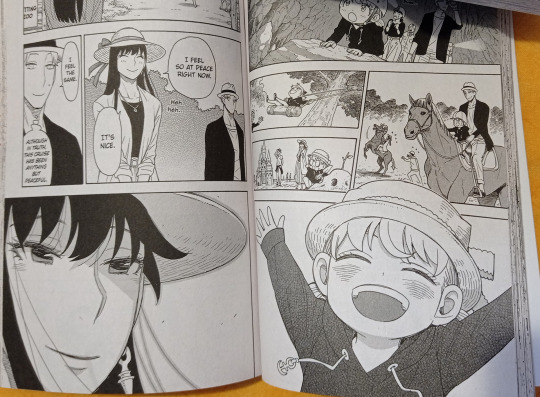
Like, look at this two-page set. The very first things that catch your attention when you turn to those pages are Anya's and Yor's smiling faces. There's very little dialogue all around those pages, and the two bottom panels are the biggest, with the main focus being how happy and relaxed those two characters are. The last panel is Yor's face - the reader is meant to turn the page with that being their last image of the set - so practically the "experience" of those two pages starts with those smiling faces and also ends with them.
And then you turn the page, and the only silent panel is of Twilight's eyes; only him, only his eyes, with a yearning, melancholic expression.

A stark contrast to the previous spread. Anya and Yor side by side - Twilight is alone. Anya and Yor full-face - Twilight's eyes only. Anya and Yor smiling - Twilight brooding. Anya and Yor get nearly half their pages' length - Twilight gets about 1/5 of his. Anya and Yor in bright light - Twilight shown in a darker light.
Panel placing plays a huge role in graphic stories. You don't just place any panel wherever, from whatever angle and with whatever dimensions. It's a whole part of the art and so I don't doubt that that placement of Anya and Yor's faces was done in order to contrast the small, "sneaky" placement of Twilight's eyes in the next spread.
This is a moment that Twilight has no idea how much vulnerability he's exposing, just by the way he's looking at Yor. And even that is tied to the way his panel is shown - small, quick, as if not really meant to be seen. Because he's a spy and all that.
Again, contrasting Anya and Yor, because they don't feel the need to hide their emotions. They feel free to express their happiness, and that's why they get a full focus on their respective pages.
Also, Anya and Yor are side by side. Anya accepted Yor as her mother from the very beginning, and Yor has also accepted her place in the Forger family, and so they're shown next to each other to show how they already consider each other family. On the other hand you've got Twilight, who is still deep in denial and feels he has to keep his distance from them, and so he's shown on his own.
Along with watching the anime first, I've also decided to have my first experience of the manga in a physical form, and that has been a very telling experience in that matter. It really hit home, to see those beautiful, detailed panels of a happy Anya and Yor side by side, and then to turn the page and to see a melancholic Twilight on his own and only his eyes, as if he's hiding - even though I knew it was coming, since I'd already watched the respective anime episode!
Anya and Yor feeling free to enjoy and relax and feel, and Twilight closing himself up despite the yearning in his eyes.
There's so much that can be said with silent panels, if one knows how to place and present them correctly. And it seems like Endo has an amazing grasp at that, and the printed version of the manga makes that even clearer.
(again, anime "only" here, don't spoil me for the rest of the manga please 😁)
#Spy x Family#sxf meta#again that's one of the main reasons I hesitate reading the manga#because the latest updates are only in digital form#and for me at least they lose such impacts as these#so I prefer to wait and enjoy it properly on my own time
136 notes
·
View notes
Text
The (New) +Anima Au Guide!
A few months ago, I made a post about the basics of +anima, and now I realize it was kinda bad, so I'm making it again! So, here's a little guide to the basic world of +anima - mostly how anima work - in hopes to inspire people to create +anima aus!
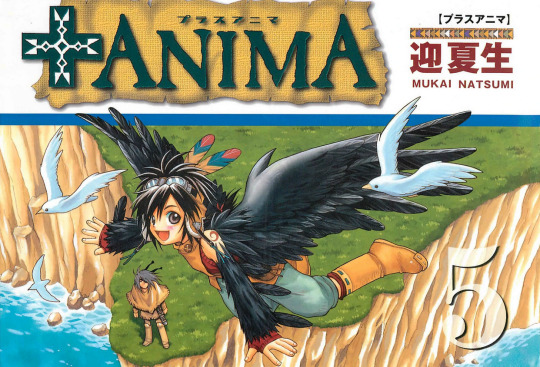
What is +Anima?
+Anima is a ten-volume manga written by Natsumi Mukai. It is very good and cute, you should read it! It revolves around a world where certain people have something called an anima.
When a child is put into a life-threatening situation, there's a chance that they will get the abilities of a nearby animal - granting them wings like a bird, or tail of a fish, for example - in order to survive the situation. It's like if trauma gave you cat ears!
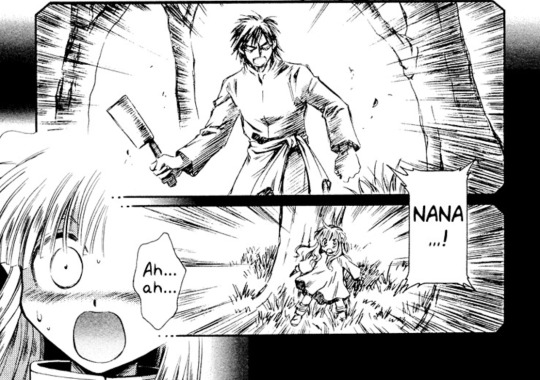
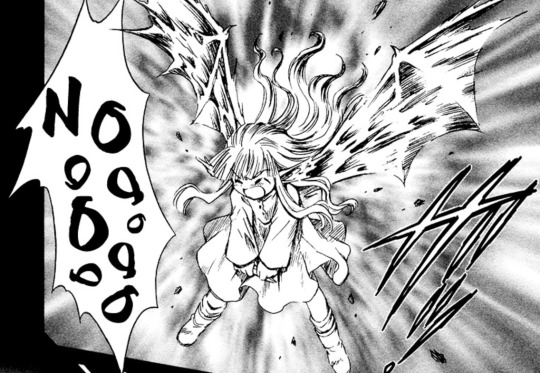
Nana, for instance, was running from her drunk and angry father in the woods at night, and got a bat anima. Natural anima only happen to children.
Getting an anima, or seeing someone with an anima, is rare enough that, even if people are aware of what anima are, those with bird or fish anima are often confused for angels or mermaids. Those with anima are usually treated poorly and feared as something dangerous and scary.

Those with anima are able to look like normal humans most of the time, accessing their anima and transforming back and forth at will. When appearing like a normal human, however, there is still proof of being an anima by way of a marking(s) somewhere on their body. The marking reflects the animal/trait that they have, the location usually correlates with there or how the trait shows up.
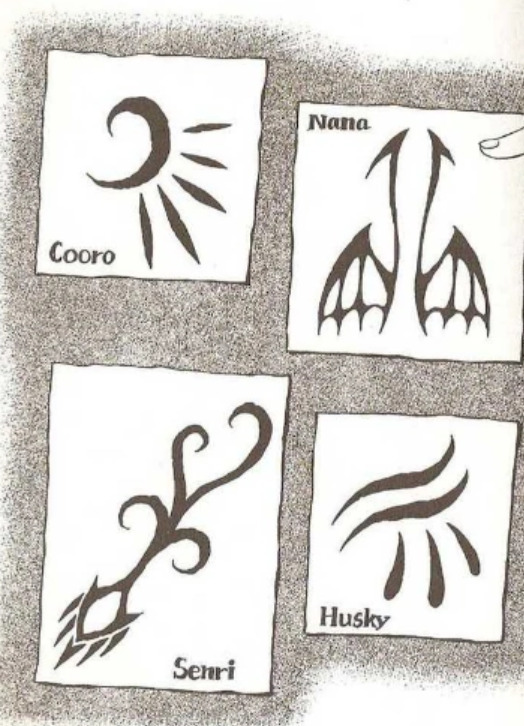
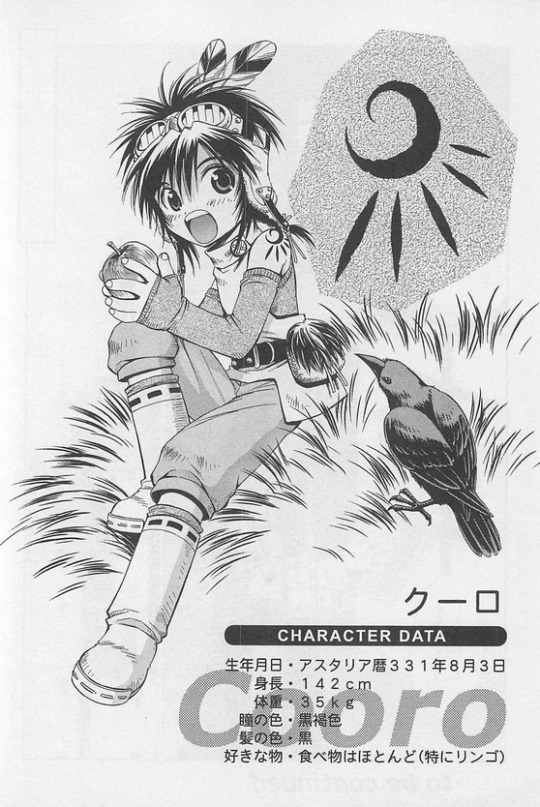
As an anima is connected to survival, children with them usually lose their anima as they grow older and find themselves in better situations. In the manga, most of the anima are either kids or teens. There are a few cases of adults with natural anima, two being seemingly homesless men (one seems to be a rat anima, while another is a bison), and a few who are of the Native American-Coded group in the manga, the Kim-un-Kur, who are known to keep their anima through adulthood seemingly because 1. it's less ostracized against, 2. their life style probably is better with one, and 3. they're more in tune with nature and their anima.
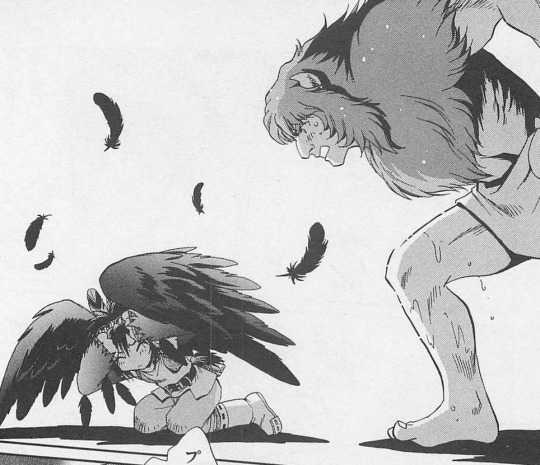
(^this is the the buffalo anima and a crow anima)
There is also such a thing as 'fake' or 'manufactured' anima, but only in a sense. There's a way to extract the anima from a person, though if the person is not willing the anima will not remain after the procedure. When willingly extracted, however, the anima can then placed into another person, though the connection between human and anima seems to be tenuous, and the anima may choose to leave.

Outside of a 'manufactored' anima, in canon there is one instance of an anima hopping from one human to another, though in that case the anima was that of a vicious and vengeful bear.
While in-fiction it's mostly hinted at and a little vague, it seems that the anima - as in the animal power itself - seems to have some degree of sentience, as it seems its the anima that makes makes the choice when to leave the human. It seems to be that the spirit of the animal literally ends up in the human that gains the anima.
Those with anima also seem to be able to do a further transformation into a more animal-like form called metamorphosis.
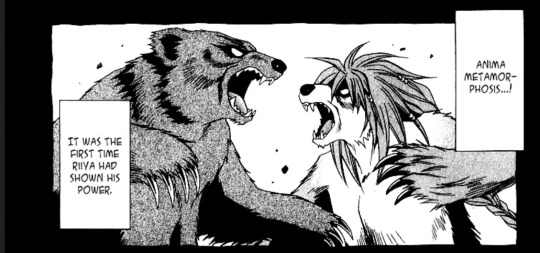
As you may have noticed me doing throughout the post, those with anima are usually just referred to as ‘anima’, though the animal spirit in the is also called their ‘anima’.
In the world of +Anima, there is also a side of the continent that has big market in anima slave trade, so make of that what you will.
Anyway, I find the world of +Anima FASCINATING, please talk to me about +Anima and make aus I love it.

(These are the four main characters of the manga! Cooro (crow), Husky (fish), Senri (bear), and Nana (bat).)
275 notes
·
View notes
Note
Hello! I know all the students at NRC use the dark mirror for going certain places during events and going back home on holidays. However, is there any instances where they mention how they get back to NRC? I do know both Ace and Deuce came back on boat and bus but is that the same for everyone? can they cast portals to come back through the mirror?
Also, thank you for all the hard work you put into this blog!♥️
Hello hello!! Thank you so much for this question, you are too kind! ^^♡
On the subject of transporting to NRC from outside of NRC, these are the only two references I have been able to find: Halloween and Book 4!

Ace says that they had to take public transportation back to the school in Book 4 because "the mirror gate wasn't open," and in Halloween he says, "the school mirrors let us go home and back instantly for holidays and stuff," but I am not sure we have heard anything about logistics!

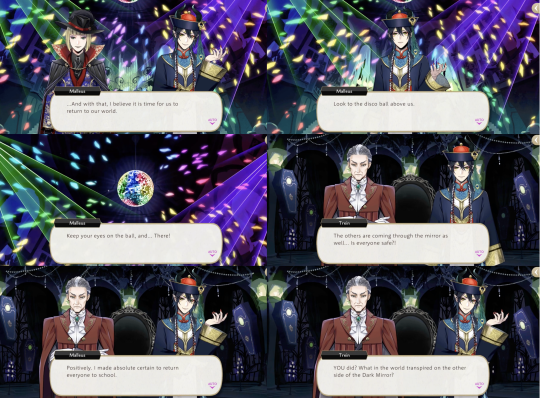
During Spectral Soiree Leona explains that mirrors are often used in magical artifacts, listing the examples of the Dark Mirror, the Hall of Mirrors, and the viewglasses. We know that the viewglasses require at least two mirrors to work, and Malleus transports the students via the Dark Mirror using the mirror that is the disco ball.
This makes it sounds as though maybe a mirror should be required for returning to NRC, much in the same way that a mirror is required for leaving it, but the students tend to appear in curious places for mirrors to be:

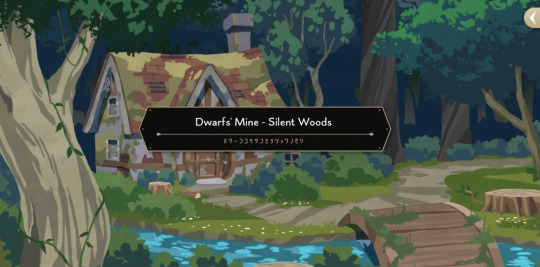
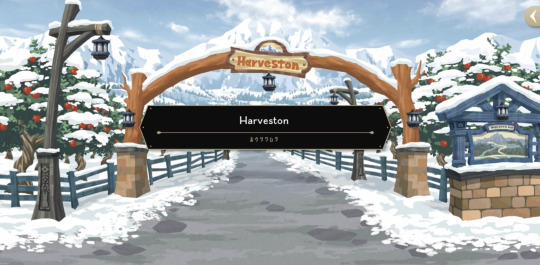
They show up just outside an abandoned cottage in the prologue and for Vargas Camp, and on what appears to be the outskirts of Epel's village for the Harveston event.
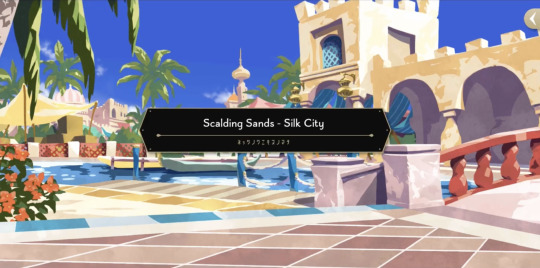

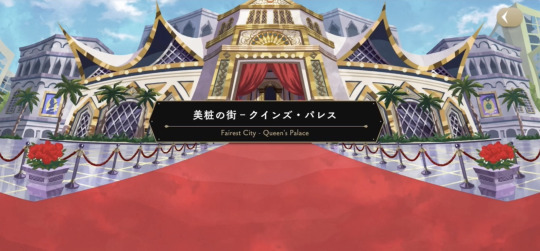
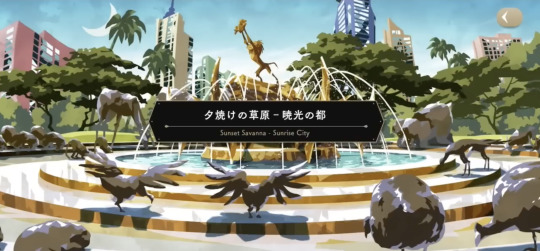
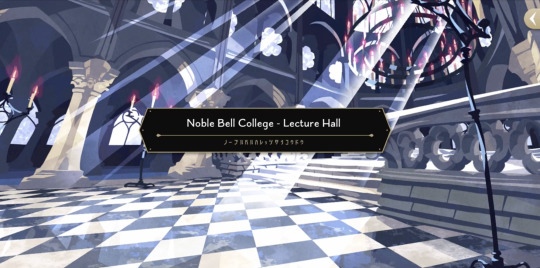
They then appear in the middle of city centers for Firelit Sky, White Rabbit, Tapis Rouge and Tamashina, while they step directly into a lecture hall at Noble Bell College.
Is it possible that all those city centers, the outskirts of Harveston, the outside of that abandoned cottage and the lecture hall all have a mirror set up specifically for mirror-based transportation?
It might not be impossible!

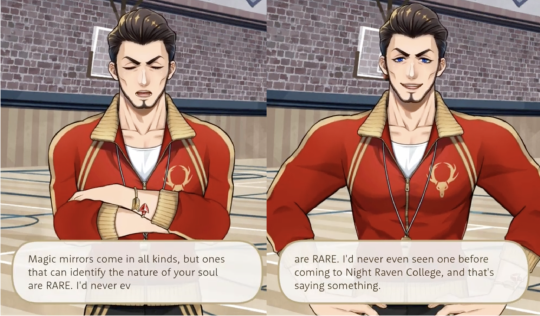
The Dark Mirror is "one of Night Raven College's most prized magical artifacts," requiring Crowley's permission to use.
Being so well guarded, setting up similar mirrors in public spaces might be unlikely, but it seems that the Dark Mirror is special (according to Vargas), doing more things than teleportation.
Maybe the mirrors in places like the woods and Clocktower Square (assuming they exist) are more generic?
I found a recent Twst Soku thread on this same topic, where some interesting points were made!
In the first novel a ghost tells Yuuya that "high-quality mirrors can be used for transportation." So maybe any mirror at all will do, so long as it is of a certain quality?
If that is the case, it would explain why the students appeared where they did in Firelit Sky, Harveston, etc.: they were the most convenient locations for Kalim and Jamil to introduce the city, for Epel to show off his village's orchards, etc., but maybe they could've teleported directly into their own bedrooms if they'd chosen to?
But that introduces a different question:
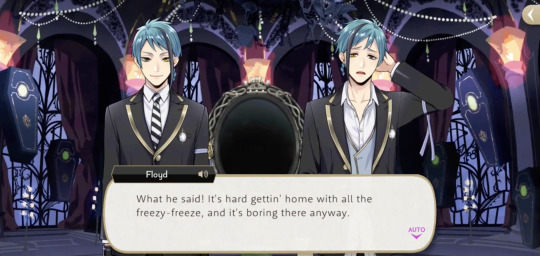
Jade, Floyd and Azul do not go home in Book 4 because of ice floes that make travel difficult--but why do they need to travel at all? Do they live an inconveniently far distance from the local transportation-mirror?
If any mirror can be used, does this mean that they do not have mirrors at home? We know that underwater-mirror-travel is possible because of Book 3, where characters go to both Octavinelle dorm and the Coral Sea via mirror.

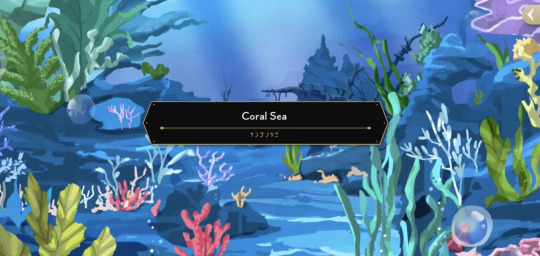
Things might still be vague as of this post, but it is almost conspicuous how the game, manga and novel have all expertly avoided answering this question 👀
Commenters in the Twstsoku thread above generally seem to agree that it might be something of a bus-stop situation, with public mirrors that can access NRC during pre-determined time slots, but I do not think anything is official at this time!
Looking forward to an answer one day :>
83 notes
·
View notes
Text
Dragon Ball Super Manga ch.91-93
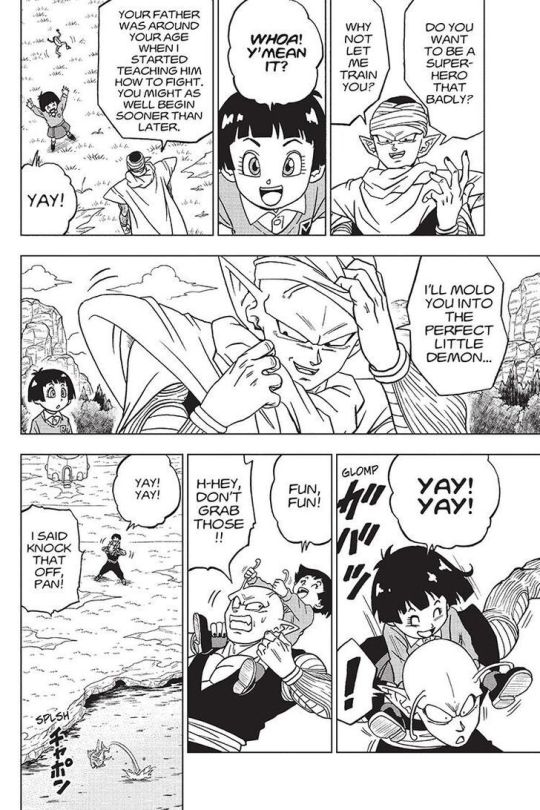
Last time, we covered the "prequel" story of Goten and Trunks adopting superhero identities and capturing Dr. Hedo. Now we get into the events of the DBS: Super Hero movie itself. I already liveblogged the movie extensively in September (here, here, here, here, and here), so for the manga adaptation I'll be focusing mainly on whatever changes Toyotaro made to the story.
First off, Chapter 91 opens with Piccolo picking up Pan from school, and when she talks about wanting to be a superhero like Goten and Trunks have been doing recently, Piccolo offers to train her just like he trained Gohan in Dragon Ball Z.
Unfortunately, this is the sort of thing we can expect from this adaptation. It's mostly a straight retelling of the movie, and the little extras that get added in don't really add much to the story. I mean, the movie established that Piccolo has picked up Pan from school in the past, but there was no need to show it. Also, the movie didn't really explain why Piccolo started training Pan, probably because it didn't need to. I think the manga pretty much proves my point, because it attempts to tackle the question, but only comes up with a fairly pat answer. She wanted to fly and shoot hand energy like Goten and Trunks, and so Piccolo offered to teach her and she said yes.
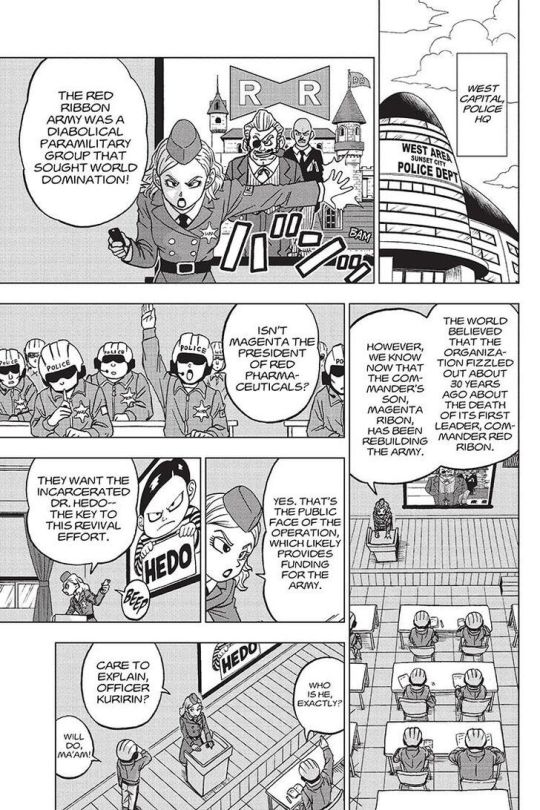
Then we get to this scene, where Krillin's boss in the West City P.D. holds a briefing on the Red Ribbon Army and their plans to recruit Dr. Hedo. This takes the place of the flashback montage that opened the movie, and it sucks.
That montage was awesome, and Toyotaro could have drawn his own version of it here, but instead he did this. We could be looking a Goku punching Tao Pai Pai, or 17 killing Dr. Gero, or Cell smirking like a boss, but instead we're in a boring conference room reading walls of text.

Look at this fucking page! It's awful! A lot of this one serves as a stand-in for Carmine's report to Magenta about Dr. Hedo. I get it, this is a lot of information to go through, and Toyotaro probably wanted to move on as quickly as possible, but part of what I loved about the movie was the way they showcased the characters and visuals during the infodumping. Carmine's report is pretty dry in the movie, but Magenta's office is interesting to look at, and Carmine and Magenta themselves are visually compelling characters. While they talk about Hedo, Carmine shows off his video editing skills and Magenta keeps screwing up his snacks
This police briefing, however, sucks all the fun out of it. This place looks like a hotel conference room with hardwood floors. All of the cops look exactly the same, and why the hell are they wearing helmets and sunglasses indoors, anyway? Krillin's boss, Sergeant Nutz, has some potential, but she has nothing to do with this story, so featuring her so prominently here is just a waste of time.
What really irks me is that the next scene shows Carmine and Magenta talking about Dr. Hedo, just like in the movie, except there's not much for them to say because Krillin and Nutz already covered it all! That's really dumb! We have two scenes designed to set up the plot of the movie, and one of them was in the movie, and actually features the main antagonists. But Toyotaro chose to emphasize the other scene instead.
So the idea here is that the police are already aware of Magenta's scheme to revive the Red Ribbon Army, and they know he plans to recruit Dr. Hedo once he gets out of prison. They also know that Hedo had that disc containing data on Dr. Gero's bioweapon, although I don't see how they could know that, since Trunks couldn't access the data on the disc and it was destroyed before anyone else could try. Hedo told Krillin in Chapter 90 that he memorized the contents of the disc, but he never said what it was that he memorized. This also goes against the storyline in the movie. In the film, Magenta had Gero's data on Cell, and the reason he wanted Hedo was because his own scientists couldn't do anything with it.
Anyway, the police seem to know everything about the Red Ribbon Army already. The only thing they don't know is where the Red Ribbon base is, so they send Krillin to follow Magenta's limo and spy on him. So we get the limo scene from the movie, except Krillin's clinging to the side of the car the whole trip, and then Hedo spots him and sends his cyborg bee, Hatchimaru, to attack him.

The gag here is that Magenta and Carmine don't even know Krillin is out there, and Hedo doesn't particularly care. The scene plays out almost exactly like it does in the movie, but with Krillin spliced in like Jabba the Hut in the Star Wars Special Edition.

Of course, Krillin gets shaken off so the base's location remains a secret, so this whole bit is completely pointless. It's just so dumb. I assume Toyotaro needed to pad out the story for one reason or another, or maybe he just wanted to add some new details so he wouldn't get bored retelling a movie like this. But if this is the best he can come up with, why bother? So far, this manga keeps "expanding" on the movie by answering questions nobody asked, like "Why did Piccolo start training Pan?" or "Why didn't the authorities stop the Red Ribbon Army?" or "Why is Gamma 1's cape red?"
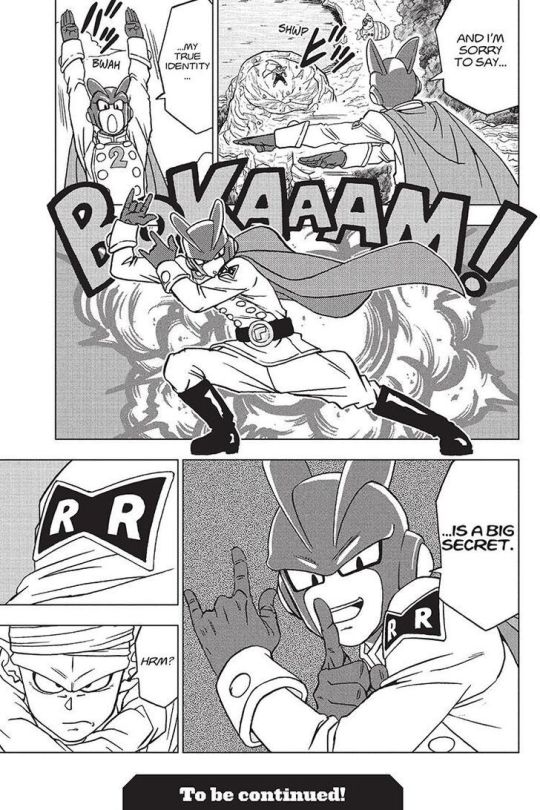
From here, it's a pretty faithful retelling of the movie, which kind of makes the "filler" scenes even more conspicuous. It's refreshing to see the actual story move along without all these pointless diversions. On the other hand, it's kind of dull, because I already covered the movie and there's nothing else to talk about here.

There is some extra stuff in the Gamma 2 vs. Piccolo fight. Piccolo loses an arm, but then he grows a new one and makes it all long to catch Gamma 2 off guard. It doesn't slow him down much, but it's something we didn't get in the movie. I do find it a bit strange how Gamma 2 notes Piccolo's regeneration ability like it's this new data to add to his files. Shouldn't the Red Ribbon Army have all of this intel programmed into Gamma 2 by now?
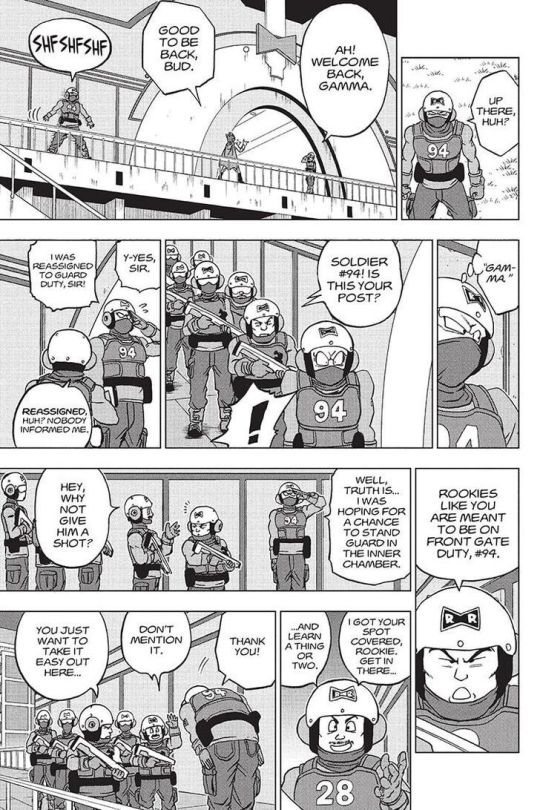
Moving on, when Piccolo infiltrates the Red Ribbon base, he gets stopped by his superiors, who remind "94" that he isn't assigned to this area, but another soldier offers to switch assignments so "94" can gain some valuable experience watching Hedo eat cookies.
Again, what is the point of this? We're just derailing the story so Toyotaro can waste a page explaining how Piccolo managed to get this far into the base. In the movie, nobody notices or cares that "94" is in the command center instead of the hangar. That's because they're all faceless, interchangeable henchmen. They wear masks and refer to each other by numbers, for crying out loud! This is why Piccolo disguised himself in the first place! If Toyotaro wrote Star Wars, he'd do a whole scene where Luke Skywalker has to rewrite the Death Star's duty roster just so "TK-421" can get reassigned to prison detail. Nobody cares!

Okay now this is more like it. We get to the part where no one can reach Goku and Vegeta because they're training on Beerus' planet, and so Toyotaro gives us a little more of the sparring match Goku and Broly had in the movie. It's not a lot, but this is the sort of thing filler is good for. Toyo also does a whole montage recap of the DBS: Broly film, which is perfectly serviceable, but it annoys me because it demonstrates that he could have done the same thing with the Red Ribbon Army flashback in Chapter 91, but instead he did the briefing scene with Sgt. Nutz. Ugh.

We see the same scene where Vegeta explains the importance of mental training, although when he talks about all of their recent opponents, he adds manga-only characters like Moro, Gas, and Black Frieza. And that's fine, although it's strange when he talks about Jiren and Black Frieza in the same breath like this. In the manga, Vegeta has gotten pretty good at "Ultra Ego", his answer to Goku's Ultra Instinct. And Goku's learned to tap into UI at will. So I'm pretty sure Jiren and Moro aren't really an issue for either of them anymore. I mean, the only reason Goku couldn't defeat Jiren by himself at the Tournament of Power was because he lacked experience using UI, and now he's much better at it.
The point I'm getting at is that in the manga, Vegeta doesn't need to do "mental training" to defeat Jiren because he's already surpassed him. And he might need it to surpass Broly and Black Frieza, but he speaks as though that's their secret, and he needs to learn how to do it himself. I'm pretty sure Broly isn't "relaxed" between attacks when he's using his full power. He was kind of freaking the fuck out back then. Black Frieza might have been doing something like that, but he only hit Vegeta once, so I'm not sure how he could be certain.
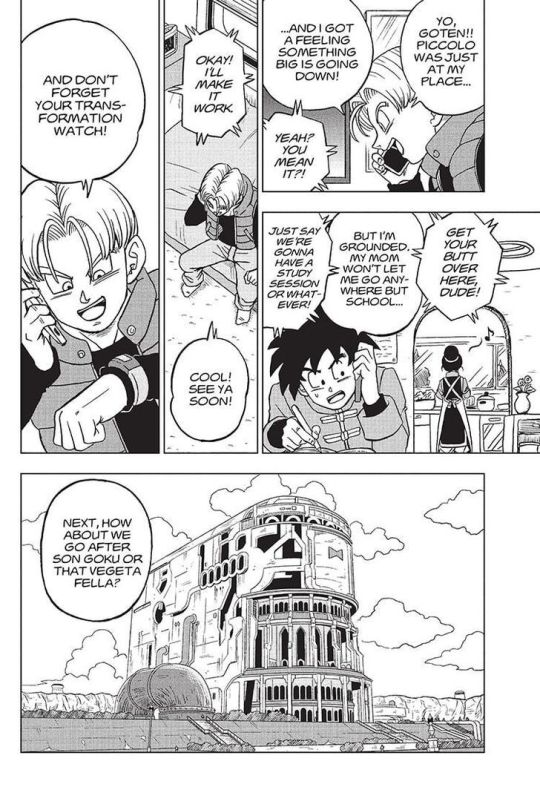
So then we move on to the part where Piccolo wishes for a power-up from Shenron, and we just skip the part where Dende upgrades Shenron to do that. The implication here is that DBS-manga Shenron always had the ability to make Orange Piccolo, and no one bothered to ask before. Kind of annoying.
Anyway, while Piccolo and Bulma are getting their...ahem... enhancements, Trunks sees them and calls Goten. They make plans to sneak out and play superheroes again, even though Goten's grounded and he really doesn't need to run up a bigger bill with his mom. I guess this is the throughline for Goten and Trunks in Dragon Ball Super. No matter what happens, Dragon Team tries to keep the boys out of it. It's not just Chi-Chi wanting Goten to study. Back in Resurrection F, Bulma tells the others that she doesn't want them fucking around during the battle with Frieza. And Vegeta ices them out of the tournaments with the other universes because he doesn't want them turning into Gotenks and being dorks the whole time. The Saiyaman X-1 and X-2 caper probably didn't do much to convince anyone that Goten and Trunks have matured.
But they still crave the excitement of being in the thick of things. They know the adults are trying to keep them out of it, and that just makes it more exciting. I suppose this is the legacy of the Buu Saga, where they had to get involved because there was no other choice, and they've had the bug for DBZ mayhem ever since, but their parents said no.
And maybe that's why Goku and Vegeta were so determined to train the boys in the End of Z episodes. Sometime after Super Hero, they came back home, heard about the Saiyamen costumes and the battle with Cell Max, and decided that they needed to be toughened up. Like, okay, you want to go fight bad guys like we do? Stop doing the poses and quit relying on fusion and learn how to do it right. And if the sparring sessions are too hard for you, you can always go back to doing your homework like your mom wanted."
That's why Goten's so frustrated in DBZ 289. He just wants to go on dates or screw around, but his only options are a) homework and b) fight for-ev-er *clap clap clap-clap-clap*.
And now that I think about it, this is where GT dropped the ball with Goten, because he doesn't really seem to have gained anything from that. Hitting the books and getting hit by Goku should have made him a bit more serious about his life, but instead he's just constantly talking to girls on the phone, because that was the only thing GT's writers seemed to think of for him to do.
I mean, they kind of got it right with Trunks, who went into GT with a lot of responsibility and skills. He didn't enjoy his position, but you could tell he'd grown a lot as a person since the end of DBZ.
So yeah, maybe I'm beginning to appreciate Big Goten more than I did before, but this newfound perspective still doesn't do much for this part of the manga. There's just a lot of nothing happening here, and throwing more Krillin, Goten, and Trunks at it doesn't help matters.
#2023dbapocryphaliveblog#dragon ball#dragon ball super manga#goku#vegeta#piccolo#pan#son pan#krillin#goten#trunks#whis#broly#gamma 2#dr hedo#carmine#magenta#sergeant nutz#chi chi#dr gero#commander red#staff officer black#vomi#gevo
124 notes
·
View notes
Note
Hello! Your blog has been incredibly helpful for me, thank you for doing what you do
Disability is a core theme of the stories I make, so accessibility is one of my most important goals. For reference, I write books but my main project is a show that’s sometimes semi-animated and sometimes similar to visual novel style dialog.
Some of the things I’m doing now are subtitles and narration that’s baked into the show itself, sticking to a simpler style of writing, and making it free to watch. It’s one part practicality and one part frustration at being told these things “ruin the experience” for others. Now they’re a core part of the experience.
But those are just the things I find personally helpful, I only have my own viewpoint. My question is what are other things I can do to make my story more accessible?
Specific things I’ve been struggling with are showing nonverbal communication (The narration covers a lot of this, but not enough) and conflicting needs. I know some things will help some people but hurt other’s experiences (ie, subtitles) which is a really hard thing to navigate! So advice on that would be helpful
Thank you!
- @interroblog
Hello lovely asker!
So I'm gonna throw out some ideas here at the start and these are in no way me saying "You have to do this". No, just me tossing some ideas out and maybe they hopefully help! 😁 Let's try this.
First off you also mentioned that it's part of your style in the way you're animating as well. I think if it's your style that you shouldn't have to change that either. It's both something that is unique to how you choose to do things and it also aids in accessibility. You shouldn't feel pressured to change it because some people find subtitles or Narration annoying. It ultimately comes down to how you want to do it, so again here are some things I could think of.
So if the site you're hosting your show on allows you to have toggle on subtitles and audio descriptions I would do that. If not what you can do is when you put your animation through you can have multiple. Kinda like with certain shows or movies you have a version in its original language and a version that's Voiced over with another language. If you want to accommodate your audience perhaps you can have a version:
Without any subtitles or audio descriptions
With subtitles
With audio descriptions
With both the subtitle and the audio description
Granted going this route may be more work than just doing it all together (I'm not 100% sure, I don't know animation very well) but it's certainly an option. I think the process of rendering and saving it at the end (having to do it multiple times) and in regards to space may be an issue.
Another thing you can do is write up a description transcript for each episode so that people can look at it for reference. Some people use screen readers or braille displays that read over this information for them if you're worried about the text itself. Here's a good example of one done from a DeafBlind film done in the 60's at Perkins [Warning for typical 60's language regarding disability]. It usually includes what an audio description would just typed out.
Another thing you can do is see and look around for anyone who is fluent in the local Sign language that your show is in and see if anyone could record and interpret it for you too, if you want to have that option for people as well.
You could also do kinda like comics and Manga do where they mark the sounds/actions on the panel/animation it self.
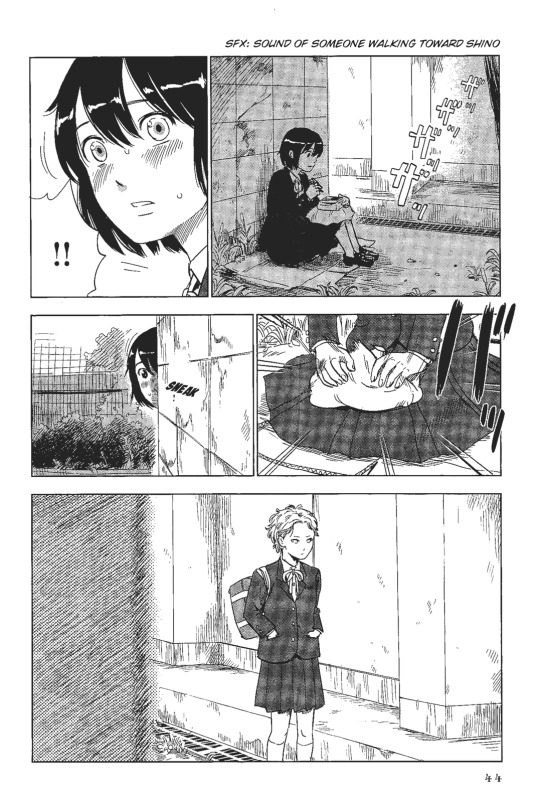
[Manga panel from the Manga "Shino-chan can't say her name"]
For instance in this manga panel there's no dialogue but the author gives us multiple cues which the translator also translates as well. There's the foot steps with the text getting bigger and bigger letting us know that the sound is getting closer and the direction, then in the next panel we have two exclamation points letting us know she's alarmed and aware. The text of the foot steps is now darker and bold and we see the streaks around the characters hands letting us know that she hurriedly wrapped up her box. Then we have the word "Sneak" in bold lettering against the wall where the character is pearing over.
Now I'm not sure what type of nonverbal communication your using so I'm gonna go over things a little vague.
Sign Language [Mostly in ASL because that's the sign language I'm most familiar with and can understand the most]
Here's two animations by @scoliwings and they're both in ASL and the way the person made them is with captions into the animation (also they're very cute and lovely). The show ThisClose also does this with their entire Pilot episode but then only does it with their ASL scenes moving forward in the series. The people who wrote and produced the show note that while they made the show surrounding the deaf community and about the deaf community they wanted the show to reach their hearing audience.
This scene that is with a translator has no captions whatsoever. While this scene between the two main characters using ASL does have captions. Then this one does have captions that go away when the characters communicate verbally.
This is a constant thing of multiple different medias is they kinda choose between which audience they want to pertain to. And whoever they choose, it usually ends up leaving the other out or not 100% involved usually at the fault of accessibility on streaming services/wherever the media is being hosted.
If someone Deaf/Hoh wanted to watch this show and there's no captions available on whatever platform is hosting it then it wouldn't be accessible to them. And if they are fluent in ASL, those parts have captions all the way through. For instance those videos on YouTube, not all of them are accessible because they don't have the toggle on Closed Captions. So the moments where there's characters who speak English and don't sign ASL, especially if the camera isn't on them when they're talking, it's just not accessible.
In the episode "Into the Mystic" on Supernatural, they introduce Eileen's character. This is the only episode that she uses ASL by itself, every other episode she is in uses SimCom and she code switches or uses English. Again captions are in the episode Everytime ASL is used except for scenes where she's signing in the background for instance this scene. From This Gifsets by @winchestergifs
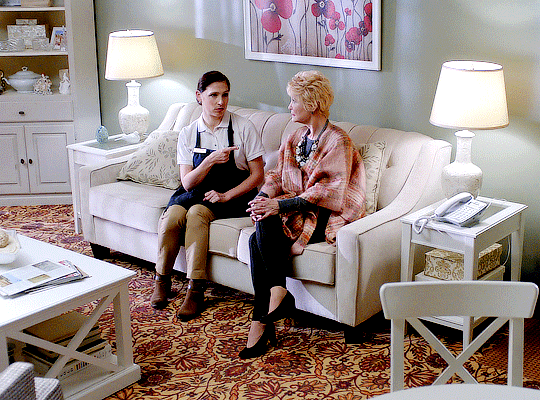
[Gif of Eileen from Supernatural. She's sitting across from an older woman on a couch and she signs in American Sign Language "You" while pointing at the older woman, then she forms her fists into a 'S' shape one on top of another and moves them to the right, she then finger spells "Bait".]
It's never translated, not even in the script or the transcript. Even while this show is targeting their hearing audience they still gloss over things like this. (I also want to note that me and Mod Rock spent a while trying to figure out the second sign and came up empty handed as well 😅)
Now when it comes to Audio Descriptions, it's usually "[Character name] signs [dialogue in Verbal Language]". If it's the first time introducing the character or the character is switching languages, then specify what Sign language off the bat, ASL, BSL, ISL (SEE, SSE,) etc. It's the same as in writing that you write the character dialogue followed by "[pronoun/character name] signed". The shows that I know of that have characters using Sign language and have Audio Descriptions is The Boys (kimiko's scenes), ThisClose also has them, Bridgerton (episode 1 scene in s3, it's one scene in BSL but it's there!), and I'm pretty sure Echo does too (it should, I'm looking at you streaming service) but I've yet to watch that last one. Listening to them might help you with getting a grasp of writing them if you have any signing characters.
Ex. Eileen signs in ASL "You sure you don't want both?"
Another thing with Sign language though is body language and expressions and even things like story telling are there also. So describing an action can give a lot of context of feeling and what is going on in the scene. Here's another ASL animation that is in the works and they go more in detail of how they are animating body motion, face expressions and such. Craig of the creek is an animated kids show that also has BASL and ASL in it (and I love how they go about the characters dialogue, the signs are so well animated, and the friend translating and the others learning for him too.)
There's also Pro-tactile & Tactile Sign language. Granted I've never seen or do I know of a show/movie/short with pro-tactile in it or Tactical Sign Language but if anyone were to do that the audio description would probably be like "[Character A] puts their hands over [Character B]. [Character B] signs [dialogue]". That would be for the Hand over method which is Tactile Sign Language.
For Pro-tactile, this involves other forms of communication such as back channeling, mapping, haptics. It should be translated much the same I believe because these certain elements of the language are used to portray emotional tone, contact/interaction, as well as directions.
Here's some examples of pro-tactile and tactile sign language since I know it's not largely known: (all ASL)
Pro-tactile: Video 1 (Captions & No Voice Over), Video 2 (Captions & Voice Over) and it goes further into specifics of Hand placement, Back channeling while Standing & Sitting, Video 3 (Voice over & Captions). Here's five vlogs in PTASL also, no captions or voice over so Fluency in ASL is needed.
Tactile Sign Language: I was having a hard time finding videos (for some reason) but Here is a segment in a video where they show it. Here is another short video too!
Of course you don't want to describe every movement when it comes to Sign language but you want to describe the base movement. If someones Tracking, (this is where a person holds the wrist area of the other person who is signing so that it's in their field of vision) you might describe that before the dialogue. "[Character] puts their hands over [characters] wrist" and so on and so forth.
Haptics/Mapping may also be very similar but they're mostly used in describing the layout of an area someone is in, directions to somewhere, how to navigate the surrounding area. This is gonna be just explaining how they are moving. The same can be said with Visual Vernacular. It's movement to describe something or to tell a story it's not Sign language but a movement of general understanding. Here is a video where an interpreter details Visual Vernacular alongside ASL. Here's the one without the voice over as well.
AAC
The movie Come Play is a horror movie centered around a non-verbal boy with autism who uses an AAC app on his phone. His device is the one where speech is generated from the different buttons that correlate with the words he clicks. I couldn't find an example of an audio Description for this movie anywhere but it might be similar to the next example.
The Boys again also has scenes with Kimiko where she uses her phone to communicate and such. And the audio description usually sounds like "Kimiko types on her phone, it reads [dialogue]". The only difference in Come Play would be that the Dialogue wouldn't be narrated because it's already done so by the AAC device in the movie, but subtitles would be needed.
Speechless gives a lot of examples between low-tech and high-tech examples. This scene in particular where all the characters are in one scene. The main character (JJ) uses a laser pointer and a word/alphabet board with the assistance of an aid. In this instance the aid reads aloud everything that JJ communicates. If you're one on one though, much like with sign language, you wouldn't really read aloud everything they say especially if it's a private conversation. Instead the pov would probably show the characters AAC method they use whenever they communicate. For the audio description it might be something along the lines of "[Character] points and says [dialogue]".
I've never seen other types of AAC in media so it would probably be the same when it comes to Audio Description when describing another method like print on palm. it might be something like "[character] grabs their hand and writes [dialogue]".
In the show In The Dark the scenes with braille are described as "[character] runs their fingers over the braille, it's read [dialogue/text]". And on that topic, In the show All The Light We Can Not See, it has a really (really really really) good basis of what an Audio Description should be like. It also has multiple featurettes and an audio introduction with it that goes more in depth to explain the costumes, settings, the characters, and other visual information that is often important but left out in the audio descriptions due to the pacing of the show/film.
Immersion was the goal, much like with the production of Romeo and Juliet in PTASL that was performed. Introducing your characters and settings in a little short animation before hand or at the begining as a little segment may be something you can do/consider.
This video details some other forms of communication that I may or may not have left out (Auslan & Voice over). Finger Braille (Video of one handed with translator), Lorm Method, Touch Glove alphabet Method, and some other methods I think can all be described relatively the same. You want to describe the base action of what they're doing (writing, pointing, typing, grabbing, lifting, touching etc) and then focus on their dialogue.
Also I don't use any form of AAC to communicate so if anyone who does finds error, please correct it. Or even if there has been a discussion on this before among the community please reiterate or link to it so we have first hand experience and voices as well.
Known problems with audio Descriptions
Here's a Small history and more in depth article written by someone who needs audio descriptions. They primarily talk about its lack of rush to be used in cinema and primarily the UK.
Describing everything but the characters race: I've heard that this is an issue specifically for Netflix that the audio descriptions are good but they never mentioned the race of the character which some people have made note about. (I don't know much about this I will say just I've heard it around here and there)
Here is a post that goes more into detail about Audio descriptions as well by @accessibleaesthetics. And here is an all around really Good source as well called The Audio Description Project.
Forgetting character entrances & exits: This is important because people need to know what characters are in the scenes. Much like in a play with stage directions you need to know who comes in and when they exit.
Over describing/under describing: I read a debate about the use of over describing and under describing when it comes to AD's. The example given was when describing facial expressions. Option one is to just say "[Character] is surprised". Option two is to describe the facial expression in all its little details "[Character] opens their mouth, their eyebrows raised and eyes wide". Under describing in general seems to be a issue but when it comes to things like body/facial expressions it's best to keep it simple and to the point for another reason that I list down below.
Forgetting small details: the audio descriptions of All The Light We Can Not See, and The Boys do a fantastic job of small details. For others some things are glossed over but then don't make sense later on in the scene. For instance, if the character picks up a knife and this isn't narrated but then the part of them stabbing another person is then, it's kinda like "Oh well I guess the character picked up a knife at some point" but the exact moment isn't specified. In this article, the person who makes Audio Descriptions tells that he had described someone as Smoking a cigarette when he was in fact smoking Weed. He says the reason he realized the difference is because these are two separate substances that change the perception of the character. The little details matter because of the implications and importance to who is doing it and why, when gathering all the information and understanding a character.
Misnaming/mixing up characters: The same article I listed right before also says how mixing up characters is an issue sometimes too.
For audio descriptions in general I think listening to a few different ones might help with getting a grasp on how to do them/better do them. AudioVault is one place that if you can't find audio descriptions of your shows or movies, they might have it there. In this instance, maybe listening to your favorite movies or shows with the audio descriptions on might help you. Most shows/movies that are original to Netflix have them, the same with other streaming services like Peacock and Amazon Prime.
I don't use audio descriptions a lot because my tinnitus makes it difficult but I sometimes turn them on (when available) to understand scenes that are confusing to me. Certain actions and how the cameras frame them don't make sense to me sometimes, or even I can't see because of the lighting of the show or movie and so I need to know what's going on. This brings us to that beside people who are low vision or blind, many other people use Audio Descriptions for different reasons too. The same points can all be made for people who use Subtitles/closed captions as well.
Issues with captions/Things that need to be more common with captions
Names: Some captions have the names of the characters next to their dialogue. A lot don't do this. I think it should be done because of many reasons but mainly it makes it easier to follow along for everyone who uses captions.
Tonal Cues: As I mentioned before Tonal Cues in Captions would be so very helpful for a lot of people.
Don't censor: Don't censor swear words, slurs, anything, write it as it's said. Unless it's actually censored in the audio (which is usually done for comedic reasons) then do that.
Lyrics/music/background sounds: So not only making sure to include the songs that are playing over certain scenes but also making sure to include the soundtrack and background music that is playing. Almost every movie and show uses music as an indication for tone, often times characters or certain situations have their own theme too. These are all important to note when writing captions. The caption writers of Stranger Things did amazing when it came to background noises, writing every creak and bang is important especially if it's being heard and reacted to by either the characters or the audience.
Include language changes: This has long been an issue when you're watching something in one language and then when they switch languages it just says "Speaking in [language]". Instead write out what they said in that language. So instead of "Speaking in Spanish", actually write out "Sana sana colita de rana". If the character knows what they're saying because they speak the language you can also put another set of subtitles under it translating it. If you're doing a sorta comedic scene where the audience needs to know what is said but the character doesn't, then do the same, write it out in the language "Ay dios mio!" And then under/above it put the translation "Oh my God!".
Include different speech patterns: If the character has a stutter write it, if they're slurring their words together write it.
Auditory/Visual Learners: Some people just do better retaining and understanding information when it's in an auditory form. For some people, they're able to retain information more by reading it rather than hearing it as well.
People Who Have Trouble With Social Cues: Okay so a continuation to the "Over Describing/Under describing" bullet points above. For people who have trouble reading body/facial cues, the audio descriptions help by describing it as The character is happy, scared, shocked, surprised etc. This is part of the reason why it's best to use those words instead of describing every movement that goes into a person's expression/body language. Like wise Closed Captions with Tonal Cues would also help and serve much of the same purpose but those are rarely ever seen (in my experience).
Help People Learn The Connection Of Words And Actions: a lot of people are always learning new languages and being able to connect the word to the action helps with the understanding of new languages. Again the same for closed captions, being able to look at how words are spelt while listening to them helps grasp a better understanding.
Overstimulation: For some people looking and listening to something at the same time can be too much and it becomes overwhelming. I know I often turn off the sound to a lot of movies I watch and just use subtitles because sometimes commotion/yelling especially in like action movies is a lot. For some people, a lot of visual movement and constant rapid actions can be overwhelming as well.
Dark Screens: As I mention, especially more recently in the media industry, things are a lot harder to see nowadays. The same can be said with dialogue and why a lot of people may opt-in for subtitles and captions because things are just so hard to hear now.
The Busy Bees: Some people just like to multi-task and much like an audio book, you can do something (chores, crafting, homework etc) while listening to the show and not miss any visual information. Multi-tasking also helps some people concentrate better on what they're working on too much like music helps some people.
People With Other Medical Conditions That Make Viewing Screens Inaccessible: If your having a migraine or headaches, a screen is the last thing you want to look at, and for some people, noise is a trigger for them. They're also a known trigger for many people with epilepsy/seizure disorders. People who have photophobia also may AD due to the light sensitivity. People with ADHD, autism, Prosopagnosia, Processing Disorders, and many many other things that I can't possibly list them all, all may use Subtitles or AD's for multiple different reasons.
Okay, that was a lot, got a bit long, but hopefully I covered everything! Things could be more organized but it works so hopefully this helps! I'm not very familiar with animation so anyone who is, please feel free to add on in a reblog to share a few tips and tricks!
~ Mod Virus 🌸
#mod virus#and a very thank you to mod rock with the translating and helping with describing the AD on PTASL#writing descriptions#interroblog#writing audio descriptions#nonverbal representation
42 notes
·
View notes
Text
I’ll never kill. Ever again.
OK, so I didn't catch the significance at first, but after having absorbed the other Trigun canons, it really stands out to me. From "Millions Knives":
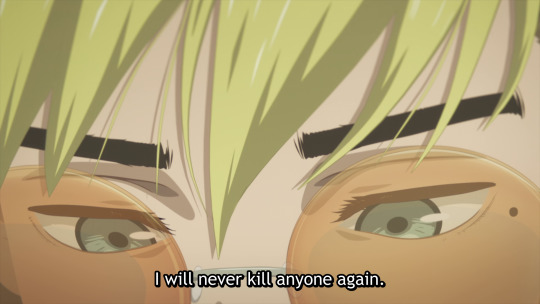
In the English dub, Vash's words are similar: "I’ll never kill. Ever again."
Correct me if I'm wrong, but in the manga and 1998 canons, Legato is in fact the first person that Vash ever actually kills.
Though arguably he does hurt people very badly in the manga, his pacifism is generally about doing the least possible amount of harm to resolve a situation.
So when Stampede Vash says he HAS killed in the past, what is he referring to? Is it his guilt over The Big Fall? Nai did a number on him by retroactively making Vash feel as though the blood of that is on his hands, by showing Nai the access code to the SEEDS05 computer. Or is there something else that happened that we haven't seen yet, something where Vash ended up actually killing someone himself?
I think either way there's a difference between the Vashes here. 98 Vash is the most pure in his pacifism. He even goes out of his way to avoid harming anyone at all, if he can. He seems almost paralyzed by it at times, it even makes him freeze up in situations where he is faced with the choice to kill. 98 ends with him rejecting his obsession with Rem in order to stop Knives.
Manga Vash is frankly not afraid to draw blood, though he avoids it if he can. He has a lot more anger and escalates his willingness to harm with the danger of the situation. His refusal to kill is very tied up to his refusal of his own suicide and Rem's blank ticket speech. After Tesla, he chose to live because of Rem's love. Rem's love also saved the humans of NML. There's a whole transference here with him, where he needs to save the humans as part of him continuing to save himself from that suicidal urge that hasn't really gone away in all that time. And when he does finally give in to that suicidal urge at the end of Trimax, he does it with the mental context of giving his tomorrows to humanity just like Rem did. He embraces Rem’s path even more.
Stampede Vash though-- There's still a lot we don't know about what happened after Tesla. We know Rem gave the blank ticket speech. In the more limited examples we have, Vash absolutely minimizes harm to others, largely by drawing fire and running from it, and minimizes harm to himself. He is extremely controlled and precise in his use of force, again escalating only as much as absolutely necessary. He is actively trying to defuse situations and bring people together. The only times we really see Vash threaten anyone are his confrontations with Knives, and there's no sense that his heart is in actually harming Knives at all.
So is his pacifism a mixture of guilt over the Big Fall, and a need to carry on Rem's work and keep the humans and plants of NML alive just a little longer? Is that really about pacifism at all? If he did try to kill himself after Tesla, which is likely, how much is that driving him here? He is carrying a lot of pain, guilt, and shame, given his regular self-punishment.
And then there's this, in the same scene:
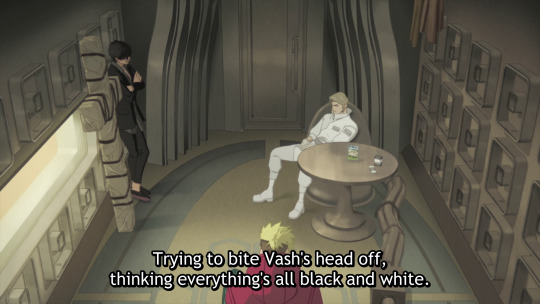
Brad tells Wolfwood that Vash's desire to save everyone on NML including Knives, is actually right.
This is absolutely fascinating to me. In 98, Brad is deeply antagonistic to Vash, partly out of jealousy over Jessica, but also because Vash goes out into NML and fights while Brad and the others in the Flying City hide in fear of "outsiders." Brad is a narrative critique of Vash's violence, and in the end he switches over and defends Vash, dying to save him.
In the manga, Brad is deeply antagonistic to Vash again out of jealousy over Jessica, but also he explicitly calls Vash a monster for his part in July and the Fifth Moon. Again, Brad serves as a critique of Vash, this time about the extreme destruction he's capable of. This is similar to Wolfwood's post-Dragon's Nest moment of doubt, where he seriously considered killing Vash to prevent Knives from using Vash's power ever again.
Stampede Brad is a narrative voice again, first antagonistic as his other counterparts, suspicious of Vash's very nature. But quickly enough he comes around and ends up as one of Vash's parental figures. And when Wolfwood doubts Vash for wanting to save everyone, Brad defends Vash. He says Vash is strong enough to find a way to make his dream happen. In contrast to so many others, instead of telling Vash to take a side, Brad says everything isn't black and white. And in fact SEEDS03 is actively working on a solution that will help Vash's dream happen, by trying to terraform NML with flora.
I think more than anything, Stampede Vash is defined by hope. He has people already trying to make a better NML. He goes out into the world and helps people and stops violence in order to keep plants and humans alive long enough for Luida's terraforming plan to succeed.
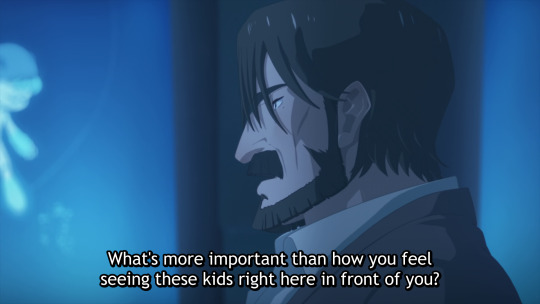
Roberto is another narrative voice. In "Humans", when Conrad shows off his work, all in the name of remaking the human race for survival without plants, Roberto calls him out, saying that his dream is not worth the cost of his monstrous abuse of innocents. Knives and Conrad's "dream" is one of humans and plants living completely separately, without depending on each other.
All of which is to say, in 98 the core inner conflict was Vash's fixation with Rem, and his refusal to kill reflected that. In the manga, the core inner conflict was the transference of Vash's denial of suicide, and his refusal to kill reflected that.
Stampede's core inner conflict so far appears to be abuse and isolation vs love and connection. The struggle of finding a way to survive while minimizing harm to others. This changes Vash's refusal to kill yet again. And all the more fascinating if Vash has already broken that ideal, if it's not a psychological block or obsession like 98 and the manga, but the choice he makes from lived experience and regret. Vash as a kind person having suffered greatly to learn his kindness.
All of which has massive ramifications for story elements that are entirely focused on Vash's refusal to kill. Such as Wolfwood. Perhaps that's part of why Wolfwood's story arc from the manga has already been largely completely by "High Noon at July". Wolfwood might still have no obvious compunction against killing, but Vash has already started to open up his heart. Wolfwood killed Rollo because he had no hope for Rollo or himself. And then Vash gave him hope for Livio, which is far more important to Stampede Wolfwood than what level of violence he should use. Even Livio shooting himself didn't take that away. Despite the destruction of JuLai, Wolfwood ends Stampede S1 with hope, for Livio and maybe even himself.
And also such as Legato. Perhaps that's why Legato's 98/manga obsession with Vash has been refocused towards Wolfwood in "Once Upon A Time In Hopeland/WOLFWOOD". Though I could certainly see Legato plotting a Death Game in revenge for "High Noon at July". Wolfwood is a safe target for Legato to transfer his anger at Knives. The big brother who needs to have his little brother taken away from him for his own good, to purify him.
Fascinating that Legato actually feels anger at Knives here, vs manga Legato who seems to be willing to accept any denigration with the eternal hope that Knives will show him a tiny speck of approval one day. Manga Legato wanted to destroy Vash as a gift for Knives, as proof of Legato's faith. Stampede Legato wants to punish Wolfwood because he can't punish Knives.
#trigun meta#trigun#trigun stampede#trigun maximum#trigun 1998#vash the stampede#nicholas d. wolfwood#legato bluesummers#trigun brad
201 notes
·
View notes
Note
You know, I was thinking a bit about the monster trio and how they all respect food a lot. And it got me thinking about their respective reasons to.
Sanji started resoecting it after being stranded and starving for 6 months, he knew how it felt to be hungry and he doesn't want anyone else to feel like this again. You also got the fact that he is a cook so of course he respects food.
Zoro I am not really sure since I don't remember any specific incident in his life, but its probably due to the strict discipline and culture he was raised in. After all he got raised with Wano costums and Wano is inspired by east asia, mainly Japan. And I might get it wrong but there is some kind of occurence where its rude to not finish your food, and its considered preciois.
Luffy has his whole thing that he just loves to eat and its mostly a gag but I dug in more deeply and...
Did Garp use to fucking starve that child?
I mean, its mostly an assumption, but when Luffy first went to Dadan's place to live she only gave him a bowl of rice and a cup of water and told him he had to work for his food. She excpected him to cry but he just went "Ok. Better than my grandad treats me".
Did Garp just fed Luffy if he completed his trainings (that involved him doing near death experience as a <7 years old CHILD) and/or only made him eat what he hunted? Is that what it is? This whole gag, of Luffy being a glutton, cherishing every piece if food he eats DEFEATING THE WORLD'S STRONGEST CREATURE, FOR A BOWL OF RICE comes from the fact that, as a child, food was quite literally just a rewards, and to him food = freedom, and he loves freedom?
Garp, I swear to Nika-
I've always loved the way OP treats food. Not gonna go full analysis on that because I'm pretty sure one already exists, but Oda keeps wanting to put food/eating in a good light. Food means life and happiness and whenever there's an important scene going on, somebody's eating. It's beautiful. It's surprisingly one of the main traits of Luffy's character. I find it beautiful how the manga keeps showing that food brings happiness and fulfillment. That everybody deserves to eat and that it could never be a bad thing.
We know already why Sanji respects food so much so there's no need to explain it. But you know. Starvation? The way his mom kept hyping up his passion for cooking? His whole character revolves around food and how nobody deserves to starve. Eating shouldn't be a privilege but most of the time it is and people should be thankful they're able to enjoy their delicious meals. So he doesn't waste food because he sees it as a life and happiness source that not most people have access to and it shouldn't be wasted.
Zoro's views are really respectful when it comes to everything. Traditions and rules? Zoro respects that. He's the one who knows the most about pirate language and tradition, so of course he's gonna respect Sanji's views on food. But it isn't just because of that because he already respected food way before joining the crew. It comes from his views on life. Food is necessary for people to live and he respects death a lot (ever since what happened to Kuina) and mortality is something real and present to him constantly. He respects food the way he respects death and life and mortality.
And Luffy... I'd say yes, perhaps it does have something to do with how Garp raised him. It makes sense although I've never actually thought about it that way. But it does look like he has always had to fight for food. But he doesn't only see food as something to fight for because Makino also prepared meals for him. I think the whole point about Luffy and food is freedom (I mean, obviously. God of the Sun and Freedom. We know how it goes). Eating is something necessary to live, but Luffy doesn't see it as a threat. It isn't "Eat or Die" for him. For him, he chooses to eat because food is good for his body and it's delicious, and eating out of pleasure and not just hunger is also part of his character. He's a man who's always starving but for more experiences and tastes and freedom, and he takes food without hesitating once because you shouldn't apologize never, ever for eating.
While Sanji sees food as something he can do for others (he's always starving and making food for everybody else because he's selfless like that and the show wants you to see it), Zoro respects food the same way he respects mortality because it's something necessary to live, and Luffy loves food because it's... Because it's just good, you know? Maybe it isn't that deep. Maybe he eats because he wants to and that's okay. He unapologetically eats and he's selfish about it and that's how it should be.
#i love writing these things and then i'm the one who has an ED. talk about hypocrisy 😭#just kidding OP has helped me so much with it kesefbkej i've genuinely been eating more ever since i started this show. surprisingly#food is such an interesting and beautiful topic in this show. my beloved#also yeah garp is a shitty guardian dude what the hell#one piece#black leg sanji#roronoa zoro#monkey d. luffy#monster trio
65 notes
·
View notes
Text
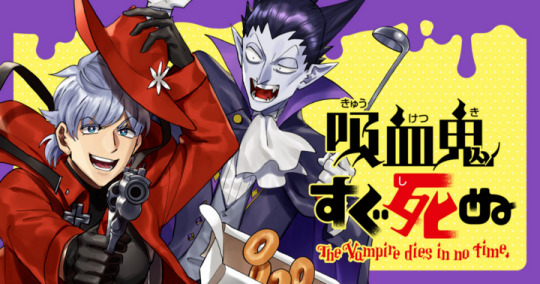
This post is long overdue but I figured better late than never!
There's a way to read Kyuushi in Japanese online and for free legally, something that was previously only possible during limited-time events. You can't immediately gain access to all 323 chapters so don't get too excited but it's still pretty cool. There's a (long) guide on how the site works below the cut!
A few months ago, Akita Shoten, the publisher of Weekly Shonen Champion, the magazine Kyuushi runs in, launched their Champion Cross site. This site allows users to read manga for FREE, legally!
To participate, you can make an account here. You're able to connect a Google or Twitter account, so it's quite easy. If you do use a Google account like I did, the site just asks for a username (it has to be unique, if someone is already using it, you'll have to pick something else) your gender (prefer not to say, male, female, or neither), and year of birth.
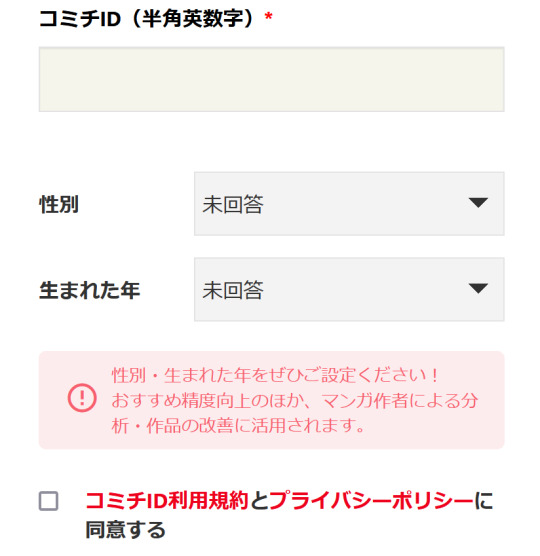
Then you just lie about reading the privacy policy by checking the box at the bottom and you're good to go!
If you don't want to connect an existing account, you'll need to supply your email and a password as you normally do when signing up for a new site.
Of course, as with most free things, there is a catch... or kind of several catches 😂 You must collect tickets (すぐ無料チケット) to unlock most chapters.
You get some for signing up, completing "missions," and using your daily free gacha attempt. The gacha can only give you 0, 1, or 2 tickets. If you want to retry the gacha, you can earn another chance by sharing your result to Twitter...

aka you just let it open the new tab but don't actually hit the tweet button lol. Just keep in mind that the second number you get overwrites the first.
You can then head on over to Kyuushi's page (remember to hit the star ⭐ to add it to your favorites!) and pick which chapters you'd like to unlock using your tickets, 1 ticket per chapter. You also unlock the ability to read 1 chapter every 23 hours (the 待つと無料/wait and it's free option). When I made a new account I was immediately able to use this free chapter read!
The first time I used a ticket to unlock ("rent") a chapter, I got a popup asking me to confirm my email address. Not sure if this will happen to everyone or just those who used a Google or Twitter account to sign up.

If this does happen, you'll just get an email with a link to click that verifies your account.
When you use a ticket to rent a chapter, the chapter becomes available to you for 15 days.

However, after reading a chapter with your daily free 待つと無料 option, you have only 3 days to go back and read before it gets locked again. The remaining time is shown to the right in gray. (Please admire Bikimi-chan's beauty in the chapter 317 preview.)

Remember to give the chapters a like!
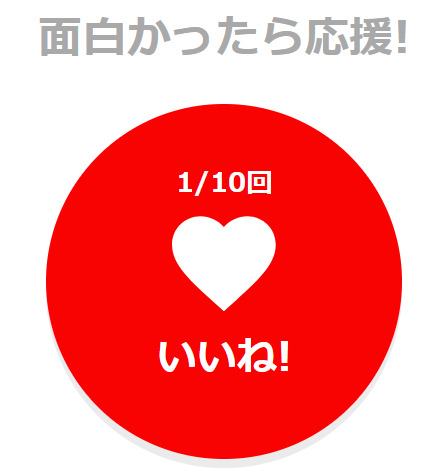
It's important to note that tickets DO EXPIRE. You can check your ticket information by clicking the number as shown here.

Tickets from different sources have different expiration dates. Daily gacha tickets expire within the day (the expiry date & time is shown in red).

On the other hand, mission tickets last longer.

This section at the top of the page shows you the soonest upcoming expiry date:

At least per my testing, the site does seem to automatically use the tickets that expire earliest!
As of right now, there are 2 chapters that can only be read by using coins, which are a paid currency.

I'm afraid I won't be testing coins out... I've already bought Kyuushi volumes as ebooks, and I'm not a fan of how you seem to have to enter your card information directly into the site. Guess they don't accept PayPal or similar services? I'm not even sure if they'd accept foreign cards. If anyone has tried/tries this out, please let me know!

So basically, you can technically read all but 2 chapters of Kyuushi for free, but it does take time to gather tickets or simply wait to read a chapter per day, and you don't get permanent access to the chapters. It's not the most convenient or reliable resource but it's a legal way to support the series. During this extended hiatus, I think it's important to continue showing that Kyuushi has an active fanbase eager for more vampire fun! 🦇
Please feel free to reach out if you have any questions about the site. I did my best to test out the features and explain how they work but this was a whole lot of information to just dump on people so I'll understand if there's still some confusion. I also could have gotten something wrong so do let me know if you notice any issues.
#kyuuketsuki sugu shinu#kyuushi#the vampire dies in no time#tvdint#champion cross#weekly shonen champion#akita shoten
29 notes
·
View notes
Text
Rakugo references in One Room Angel
(Alert: this post includes spoilers)
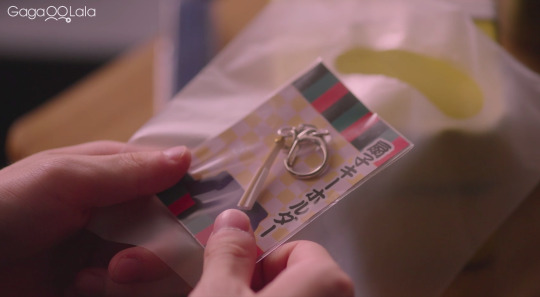
One Room Angel, the BL drama directed by Eda Yuka, based on the manga of the same name by Harada, features quite a lot of references to rakugo. Angel seems to enjoy performing rakugo both now and in his past life, and a famous rakugo reference ends up being the key for uncovering Angel’s past memories.
So, what is rakugo and what are the rakugo stories referenced in One Room Angel?
In short, rakugo is a form of traditional comedic storytelling, that was born during the Edo period. It’s been around for about 300 years now. In a way it could be compared to stand-up comedy, except in stand-up, every performer has their own stories/jokes, whereas in rakugo the performers (rakugoka) mostly perform existing rakugo stories, bringing their own flair to them. Rakugoka use only their voice and expressions, plus simple tools like a paper fan (or chopsticks in Angel's case) and a folded tenugui towel to evoke different characters, settings and items in the story.

Since rakugo was born during the Edo period and was considered entertainment for ordinary people, many classical (kotenrakugo) stories make references to everyday Edo life. There are also new rakugo stories (shinsakurakugo) being written and performed by rakugoka nowadays.
The two rakugo stories referenced in One Room Angel, Manjuu kowai ( まんじゅうこわい, ”I’m afraid of manju”) and Jugemu (寿限無/じゅげむ) are both classical rakugo. My Japanese teacher told me that these two stories are usually taught to kids at school, so even without ever seeing a live rakugo performance, most Japanese people would be familiar with them.
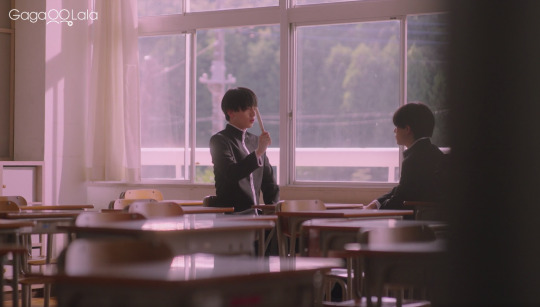
Manjuu kowai is the story that Angel is repeatedly seen performing. The story starts with an introduction talking about how different people have different tastes, likes and fears. The story itself is about a man who claims that he is afraid of manju (a bun filled with sweet bean paste), and when his friends try to play a prank on him by filling his house with manju, proceeds to eat them and then wonders if he should next tell them that he’s afraid of tea. I really don't think there's any deeper meaning for why they chose this particular story, other than that it's so well known.

Jugemu is a story about a boy with a ridiculously long name. When he was born, his parents asked a Buddhist monk suggestions for a good name that would ensure a long life. After getting a list of names, the parents couldn’t choose just one, so they ended up naming their son Jugemu Jugemu Goko no Surikire Kaijarisuigyo no Suigyomatsu Unraimatsu Furaimatsu Ku Neru Tokoro ni Sumu Tokoro Yabura Koji no Bura Koji Paipo-paipo Paipo no Shuringan Shuringan no Gurindai Gurindai no Ponpokopi no Ponpokona no Chokyumei no Chosuke.
The comedy of the story partly comes from the rakugoka’s ability to recite the long name with amazing speed, and from how inconvenient such a long name is when you just want to have a normal conversation.

Jugemu is referenced in the twitter username tks_jugem2, and Kouki is able to guess the password for the account based on Jugemu’s full name (ie what comes after two Jugemus).
The irony that a boy who ended up dying so young had a username based on a boy whose million names were meant to ensure a long life is not lost on me. I’m not sure if that was actually what Harada intended in the og story at all, maybe it’s just me overthinking, but it makes this whole thing even sadder.
Fun fact: in the manga, the password was not spelled out for the reader like it was in the drama, you had to figure it out yourself if you wanted to access a website that is linked at the end of the manga that features a special bonus drawing. I think you can still find the link at the end of the english edition of One Room Angel manga on MangaPlanet’s website.
If you want to know more about rakugo, I definitely recommend checking out Descending Stories/ Showa Genroku Rakugo Shinjuu. It's a story about two rival rakugoka, and it showcases the culture and stories of rakugo with love and detail. The original manga was drawn by the famous BL mangaka Kumota Haruko, so even if it’s not strictly BL, I think BL lovers will enjoy it (I sure did). The manga has been licensed in english by Kodansha and there is also a beautiful anime adaptation and a live action drama!


Online sources: JP and ENG wikipedia, NHK for School
#one room angel#bl talk#bl drama#harada#I've heard that your posts won't show up in the search if you add links to your posts so idk what to do with posts like this in the future#like how do I properly add sources and links to where to watch or read#sighhh tumblr
122 notes
·
View notes